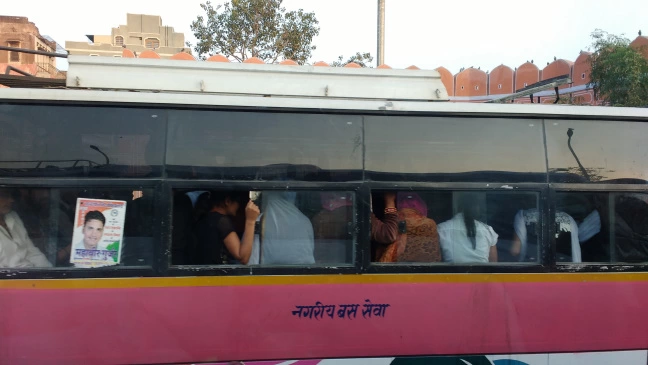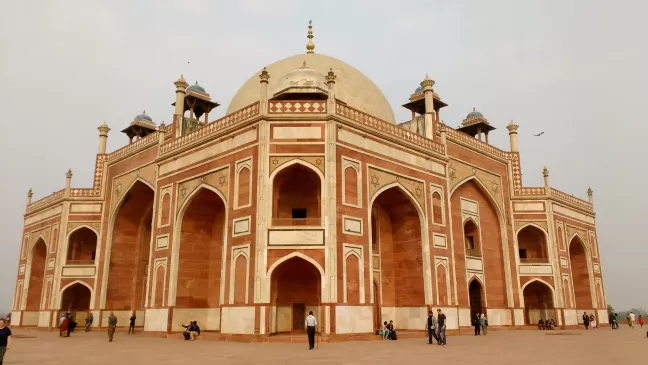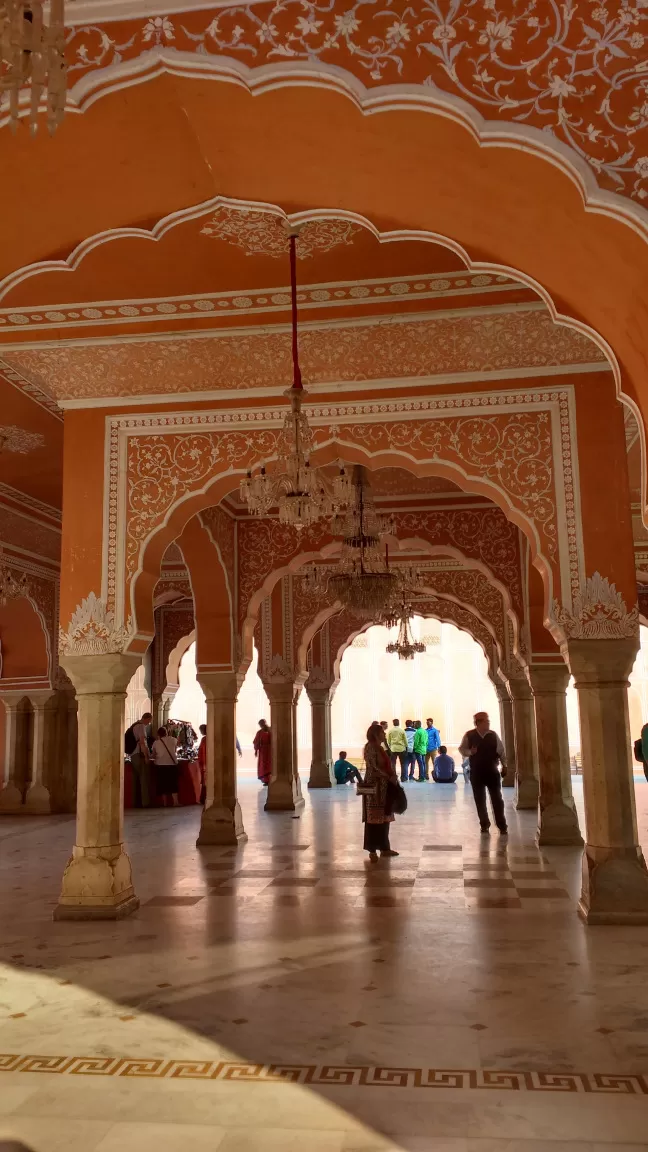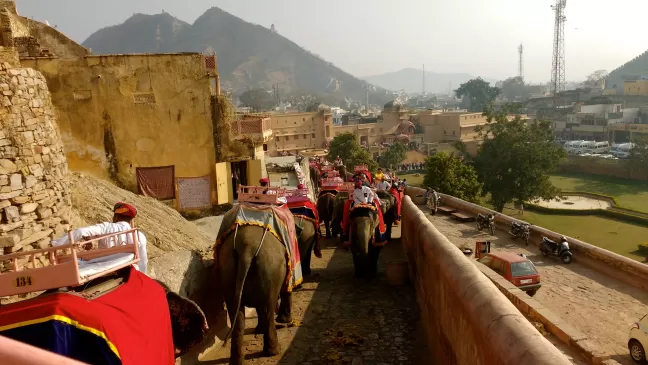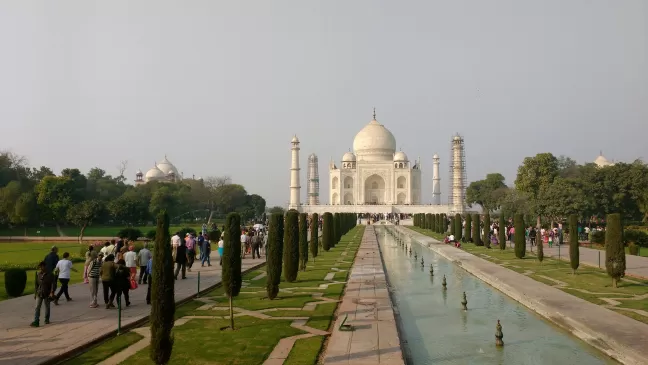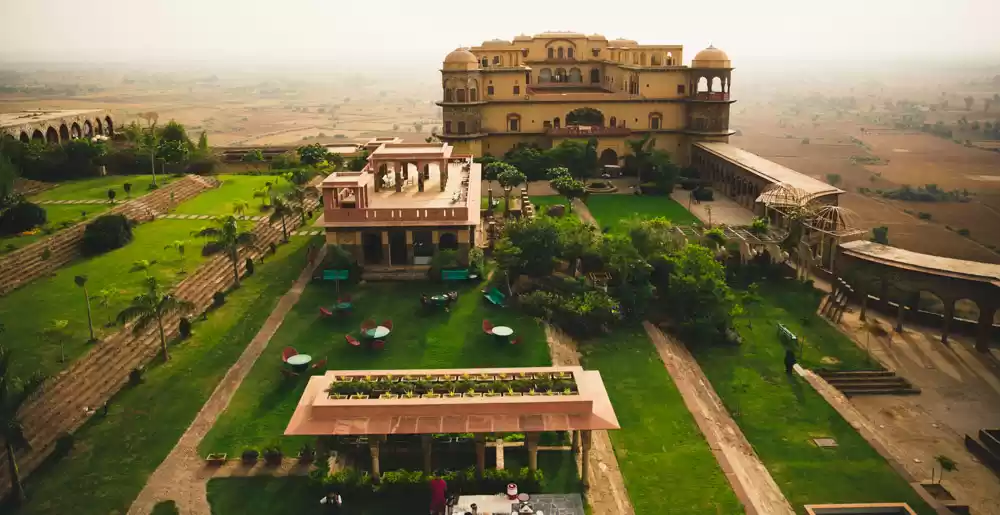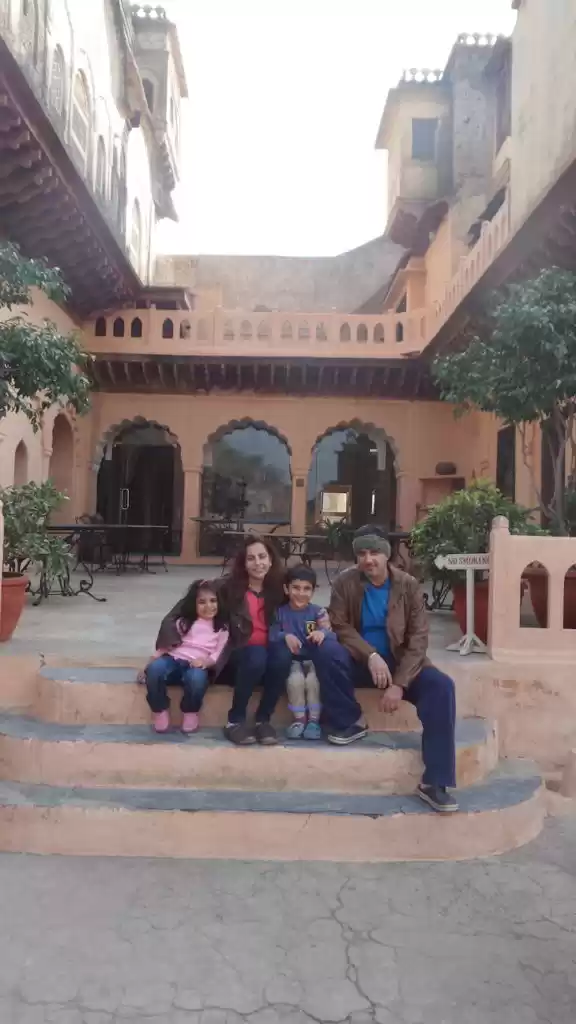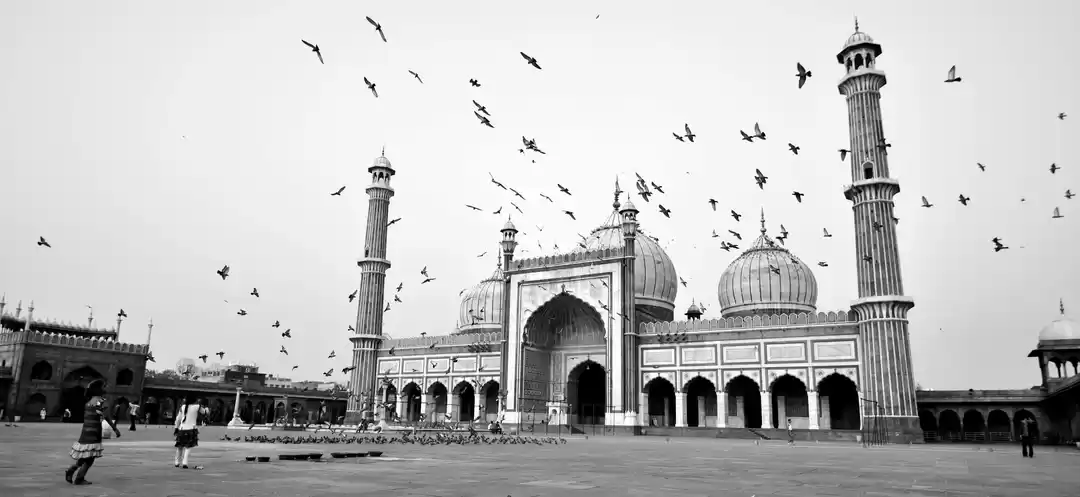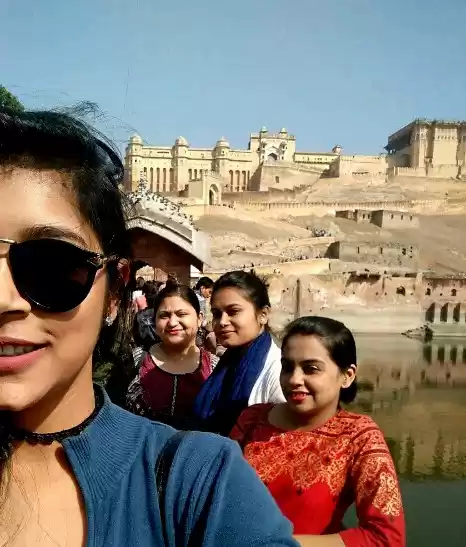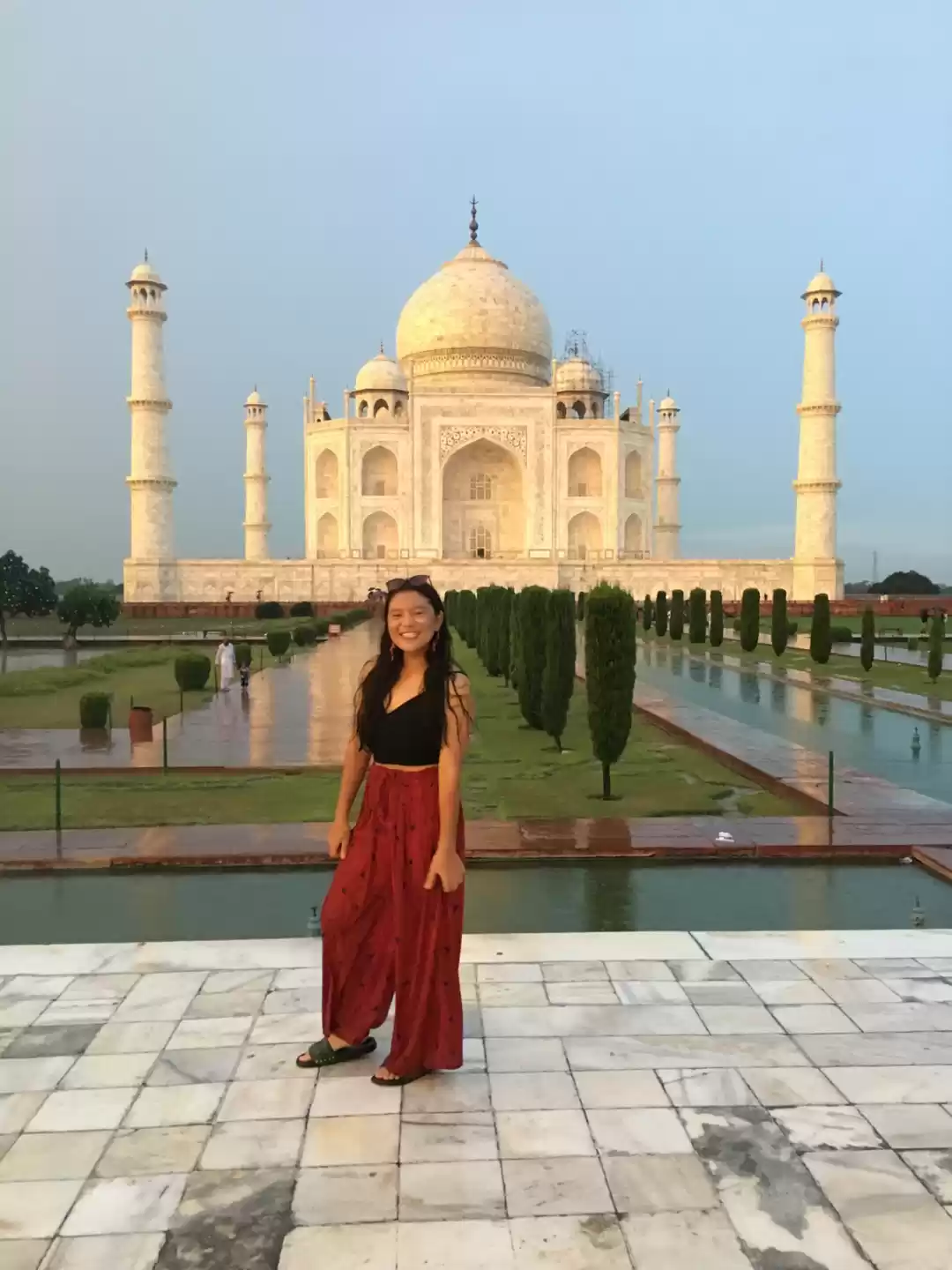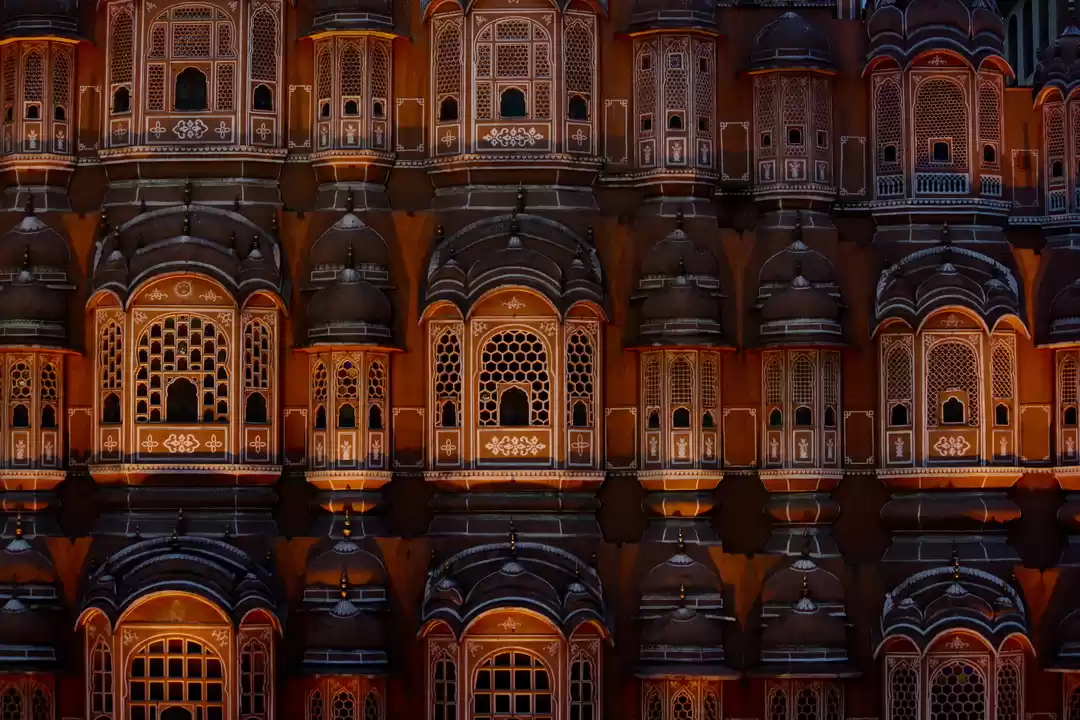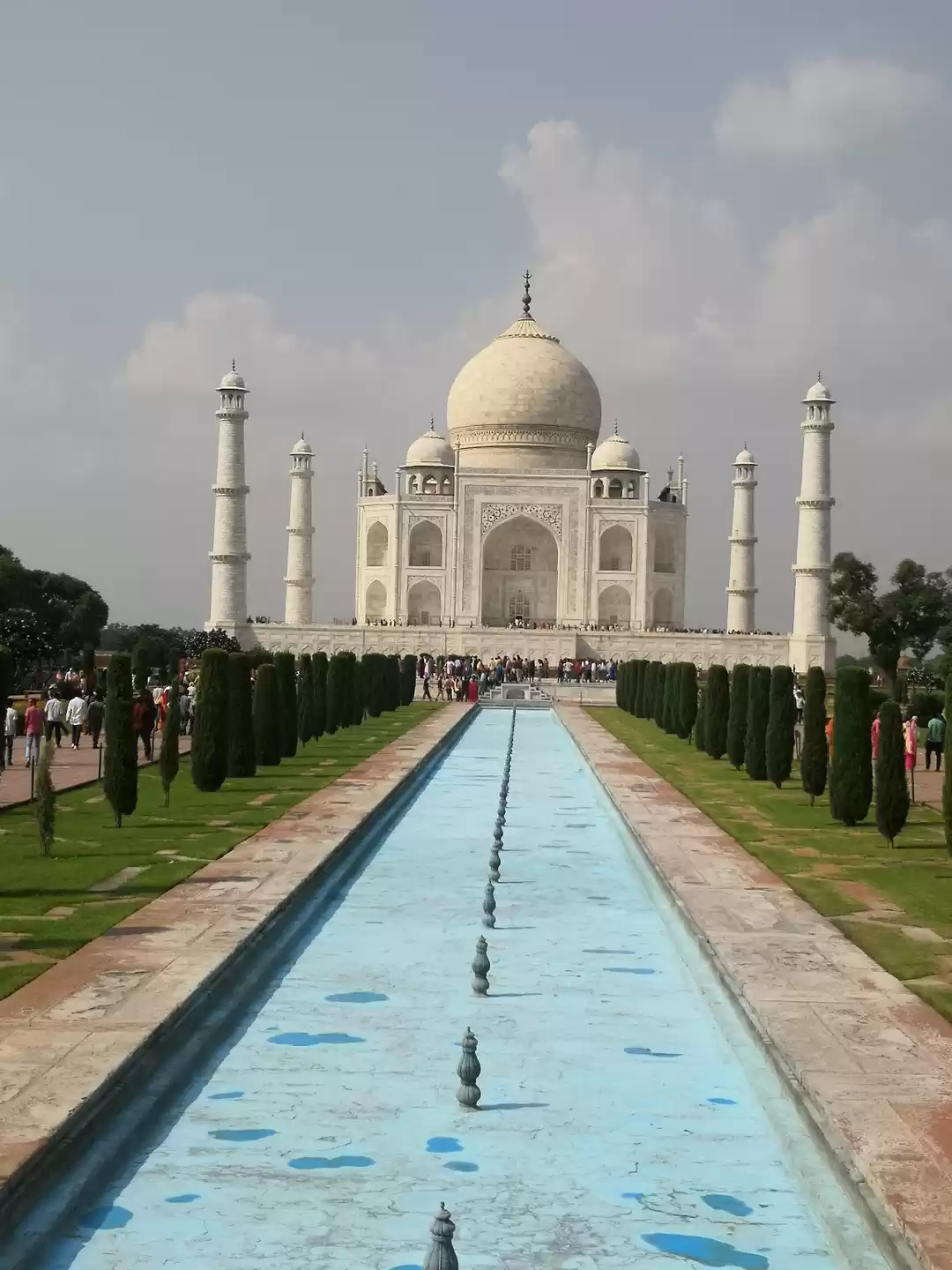No matter how many guide books you've read, documentaries you've watched or people you've spoken to who have experienced it for themselves, nothing can prepare you for what awaits you in India. To describe arriving in Delhi as 'a culture shock' would be an understatement akin to calling World War I 'a bit of a mishap'. A chaotic concoction of sounds, sights and smells,Ra the city is an affront to the senses and a test of reflexes. Let your guard down for one moment and before you know it, you could find yourself being bustled onto a dilapidated three-wheeled rickshaw or convinced you're getting an excellent deal on some tacky merchandise or 'real silk' shawls you never knew you wanted.
On our first morning in Delhi, after a sleepless night in a modern hotel room with no windows, a leaky shower that flooded the entire bathroom, and numerous switches whose function we couldn't quite seem to fathom, Laura and I ventured out into the city on our own. Little did we know that we would spend the rest of the day being the begrudging objects of fascination and wonder, and that our 'relaxed day out' would turn into an exhausting battle of wills with locals trying to sell us rickshaw rides, souvenirs and dubious tickets, take photos of us and add us on Facebook. Imagine our surprise when we discovered that most people's English was limited to the single phrase "Can I take a selfie with you?"
We'd been out the door for all of ten seconds when the first hawker sprang on us in an attempt to convince us to take a rickshaw ride. We quickly decided that the safest and most efficient way for us to avoid this situation was to take the metro straight into the town centre. This was easier said than done. Having both lived in capital cities, Laura and I are no strangers to the metro system. Unfortunately, the Delhi metro, built only twelve years ago, doesn't work quite as you'd expect, and requires you to map out your route before you buy the little plastic token for travel. This is all very well if you speak Hindi and have a bit of a clue as to where you're going; in the end, we just plucked for a station that looked fairly central on the map and hoped for the best.
To enter the metro (and, in fact, any other public place) you first have to put all your belongings through a scanner and be subjected to a brief but thorough body search - men on the right, women in a curtained-off cabin to the left. When you're through all this, everything works much the same as it does in other major cities in the world; the lines are clearly signposted, and once you're on the metro, you can follow the train's progress by a little red dot that progresses down the metro map. Names are in Hindi and English on the map, and announcements are made in both languages too. In fact, a lot of the tube stops and quarters of Delhi have strikingly English names, such as Connaught Place and Rajendra Place.
By some miracle, we emerged at Connaught Place, right in Delhi city centre, which consists of wide, bright avenues lined with shops and restaurants housed in elegant cream buildings fronted by long stone colonnades. It isn't at all what you'd expect to find in the capital of India - though I admit the little bubble of Tommy Hilfiger, Levis, Nandos and Subway chain stores may provide a welcome break from the surrounding disorder and chaos of the city, it seems somehow incongruous and somewhat disheartening to find that even here, you can't escape the steady onslaught of capitalist contagion.
There is so much poverty in Delhi and in India as a whole that it's little wonder that small-time crooks swarm here like bees around a honey pot. It took us a little over half an hour to realise that we really could trust no one but each other; several dodgy-seeming men approached us with a good Samaritan act, offering their assistance for us to find our way, and we found ourselves being led to not one but two 'government-endorsed' tourist offices. Previous experience having taught me to be naturally suspicious of such apparently altruistic behaviour in strangers, I realised the best approach would be to feign illness and get out of there as soon as possible - once we had obtained a much-needed map, of course.
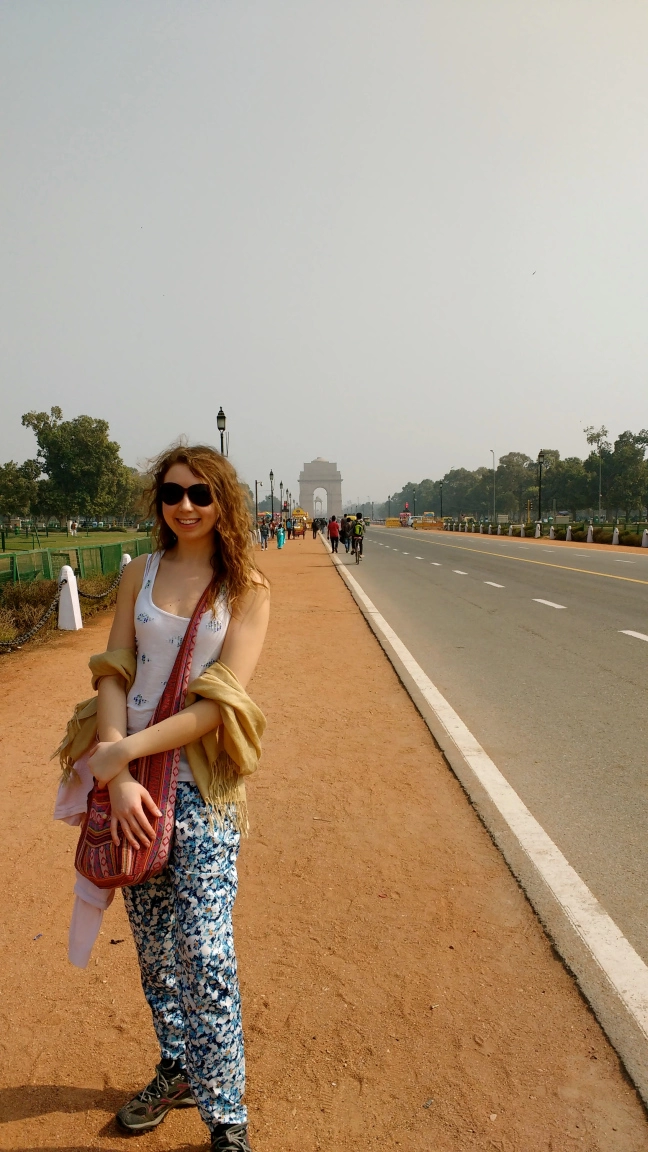
It was early afternoon when we finally arrived at the National Museum - and, surprise surprise, contrary to the warnings of our new friends, there was no queue and no need to be wearing a sari to gain entrance (shocker, that). A few hours later, we were exhausted from a combination of jetlag, a lot of walking in the heat and a long stint at the museum, and we decided it was time to call it a day. If only it had been so easy.
First, when exiting the metro we decided to stop off at the local supermarket to buy some water. After having our bags checked and sealed with cable ties at the entrance, we discovered that there was no water in stock - how could that be?! Irritated at the wasted effort, we tried to make our way back to the hotel, only to discover that our way was blocked by an enormous pile of rubble. This was possibly related to the fact all the government-employed workers had been on strike for the past ten days, as an act of protest at not having received their salary for the previous five months. So, we retraced our steps along the busy dual carriageway (which, incidentally, didn't have a pavement), dodging small children, leery men on motorbikes and a woman carrying a stack of bricks on her head.
Along the way, a tiny little girl who couldn't have been more than five years old made a beeline for us and started to beg for money. Our hearts were breaking but we knew we couldn't risk stopping and giving her money, exposed as we were, two white girls wandering alone at dusk in a strange city. When she started to pull on my clothes I panicked, and we broke into a run, only to find ourselves completely lost. Reaching the refuge of a hotel off the main street, we asked for directions, which were given to us, but not before a hopeful sales pitch from the receptionist, who enquired hopefully as to whether we definitely had a reservation at this other hotel.
It had been an exhausting and eye-opening day, but we had survived to tell the tale. And what better way to end it than with an enormous, hearty curry.
On the second morning, we were introduced to our tour group, a friendly mishmash of couples, friends and singletons of all ages, from former British colonies all over the world. It was somewhat a relief that, for the next six days, we would be exploring India under the supervision of a local guide and within the relative safety of the tourist herd. It was the first time I'd ever done a guided tour across a country, and I must admit I'd been sceptical despite the obvious advantages compared with travelling across India just the two of us. In the face of my cynicism, I discovered it was an amazing way to experience the country - especially as a first-time visitor - with a local guide who really knew what he was talking about and a lovely group of like-minded people.
During the drive into Old Delhi (in itself quite a mind-boggling experience) we drove past the first of many idols we were to see during the course of the trip - an enormous statue of the deity Krishna, the much-fabled incarnation of the Hindu deity Shiva. After escaping the chaos of the dual carriageway, we picked our way through a local market, beeping the horn (standard driving practice in India) to part the crowds. We looked on in amazement as the chaos unfolded in front, behind and to either side of the coach, and the crowds looked up with equal measures of wonderment at the wide-eyed, white-faced tourists pressed against the glass. It was like being at the zoo; only I'm still not too sure which side of the bars we would have been on in this analogy.
I might as well take this opportunity to add that, despite the stock I'd put in the safety in numbers theory, the 'selfie' phenomenon of the day before was, if anything, worse that day. From the outset, I had people (mostly slightly creepy men) coming up to me to request to have their photo taken with me, and this only got worse as the day went on - the most bizarre instances of which included being asked to be photographed with a guy's terrified-looking little boy, and groups of people just taking my photo without even asking. By the end of it, I was getting so fed up that I decided the best solution was to release my inner diva, put on my shades and drape my shawl over my head like some kind of Mariah Carey wannabe.
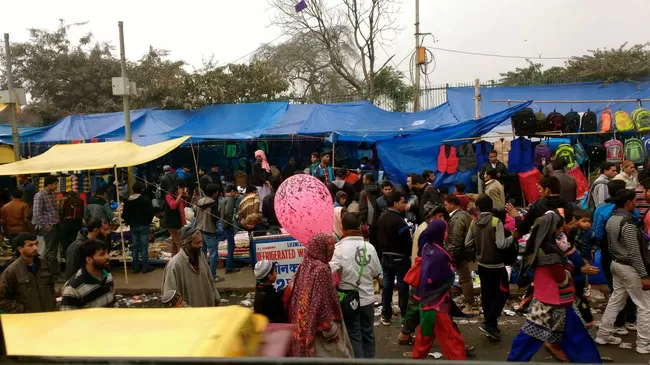
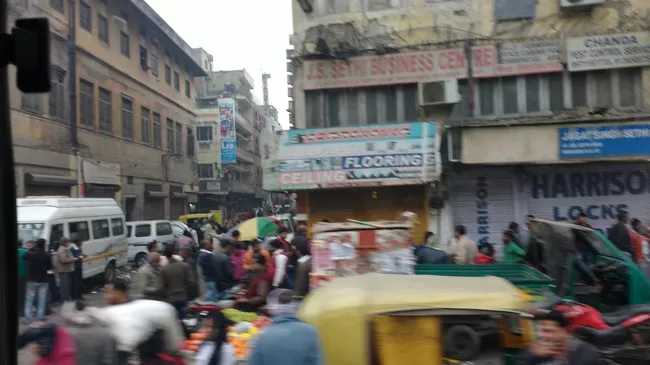
After almost an hour of crawling through the Delhi traffic, we finally arrived at the imposing Red Fort. Now only a mere skeleton of its glory days serving as the city fortress and subsequently the British army barracks, this sandstone and marble fort was constructed by the Mughal emperor Shah Jahan between 1638 and 1648 to protect his new capital city, the modestly and imaginatively named Shahjahanabad. Unfortunately for him, he never actually got to live there, since his son (whom some call 'disloyal'; I call 'rational') imprisoned him at Agra Fort to stop him spending any more of the country's rapidly dwindling riches.
The last Mughal emperor of Delhi, Bahadur Shah Zafar, was ousted from the Red Fort in 1857, and the fort was taken over by the British (who else?) until India regained independence in 1947. Despite no longer being in use, the fort is well worth a visit; it's easy to see why it has been named a UNESCO World Heritage Site, with its dramatic red stone walls extending over 2km and reaching a height of 32m at some points along this length.
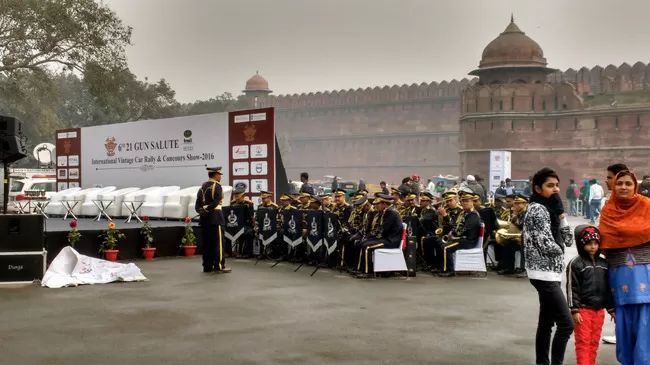
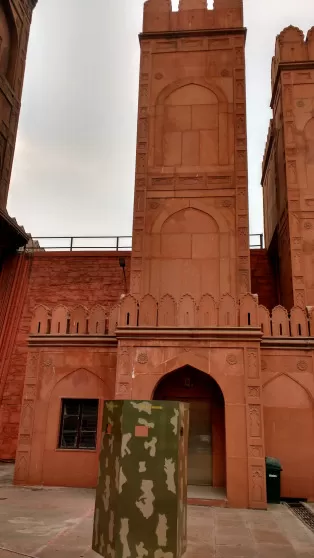
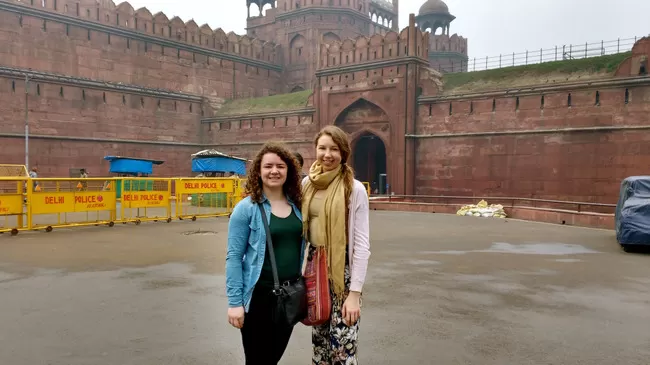
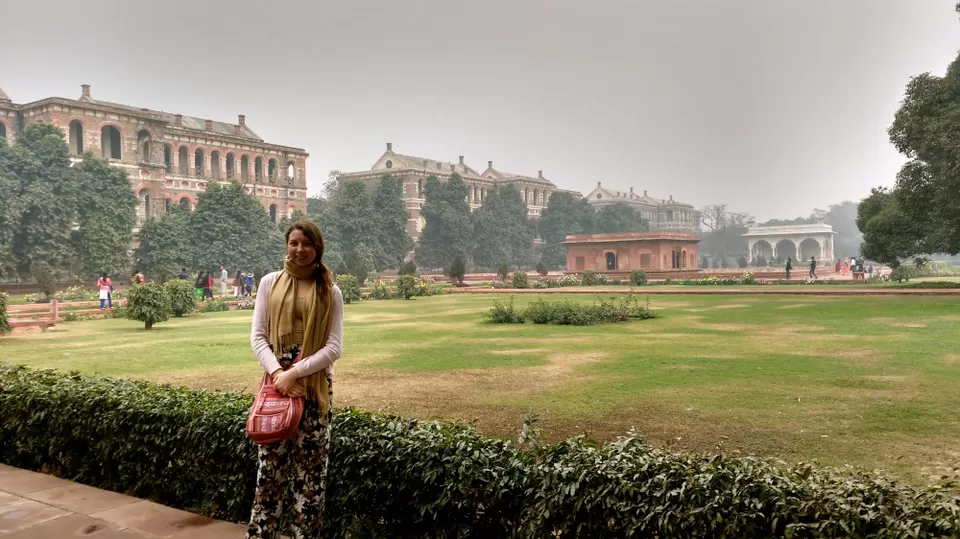
It just so happened that the day we were there also coincided with a classic cars show that was taking place in the outer courtyard. If I knew anything about cars, I'd probably have been very excited about this; our tour guide Satendra certainly was. At any rate, I did sneak a few snaps of the wealthy businessmen polishing their shiny metal toys:
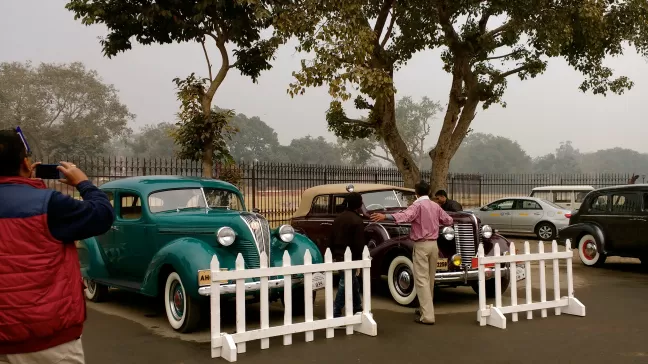
From the Red Fort, we were shown onto a fleet of cycle rickshaws awaiting us at the gates, which would take us to the next stop on our itinerary, Jama Masjid. The largest mosque in India, and the final architectural blowout of the extravagant Shah Jahan, Jama Masjid or 'Friday Mosque' boasts three gateways, four towers and two minarets standing at a whopping 40m high. As usual, the Shah employed his two materials of choice, red sandstone and white marble, to create this colossal complex, which can hold up to 25,000 people.
Unfortunately, by the time we got there the heavens had unexpectedly opened, rendering the visiting experience slightly less enjoyable - particularly as visitors are obliged to remove their shoes upon entering the courtyard. On the plus side, we did also have to don some very sexy gowns and shawls, so at least the rest of our bodies were kept nice and dry, even if we did get rather soggy feet. Another benefit of having a tour guide is that we had someone to guard our shoes while we took a look around; leave them unattended and they're sure to get swiped.
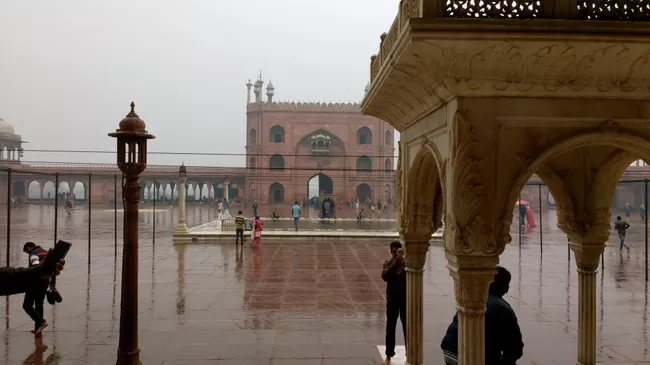
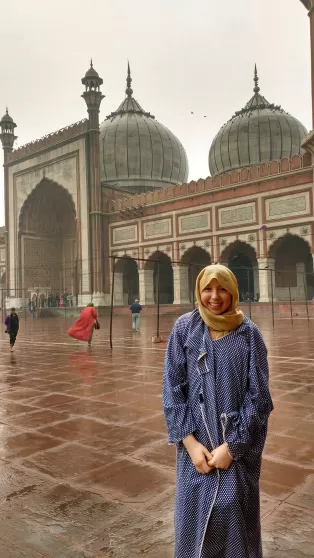
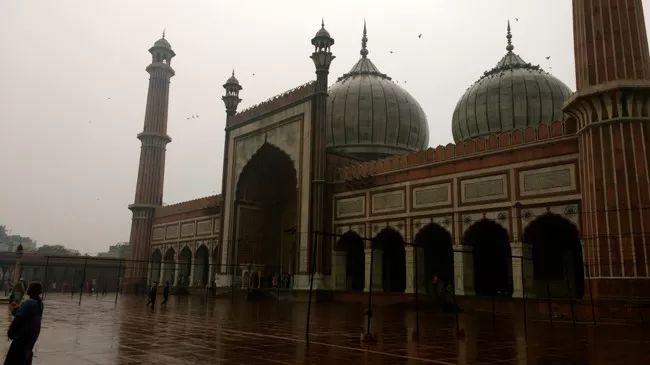
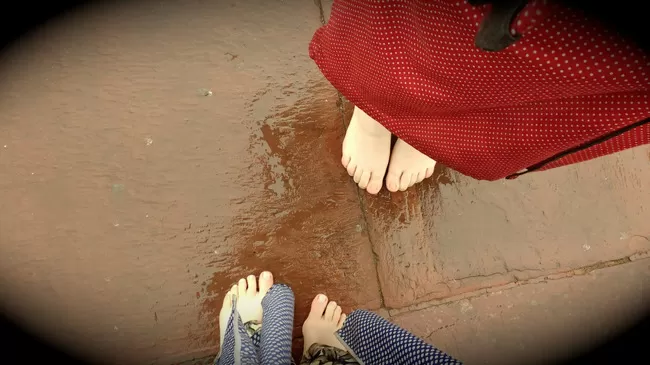
Then it was time to head to Raj Ghat, the gardens now serving as a memorial to Mahatma Gandhi, as he was assassinated here on 30th January 1948. Incidentally, what you might not know (as I certainly didn't) is that Gandhi's actual name was Mohandas Karamchand Gandhi - the honorific appellation 'Mahatma', meaning 'high-souled' or 'venerable' was first given to him in South Africa in 1914.
Gandhi was assassinated by a Hindu zealot at point blank range; it was customary for Indians to pay respect to their elders by kneeling at their feet, and so, under this pretence, Gandhi's killer was able to get so close he couldn't possibly miss. A somewhat cowardly way of going about it, if you ask me - and Gandhi's alleged last words, "Oh God" (which sound to me more like a blurted curse than the profound utterance of a holy man), don't really seem to merit their fame either. Of course, it's natural to wish to glorify the death of someone so influential and so inherently good, but I do think that, given the amount of really poignant statements Gandhi made throughout his lifetime, this was a poor choice of quotation to use as his epitaph.
The rest of the memorial was very well done - since the traditional Indian funeral proceeding is to cast the person's ashes into the River Ganges, Gandhi is commemorated by a large black stone surrounded by lush, symmetrical gardens. Visitors can remove their shoes and walk right up to the stone, or ascend a ramp leading to an open veranda lined with colourful flowers, which surrounds the memorial.
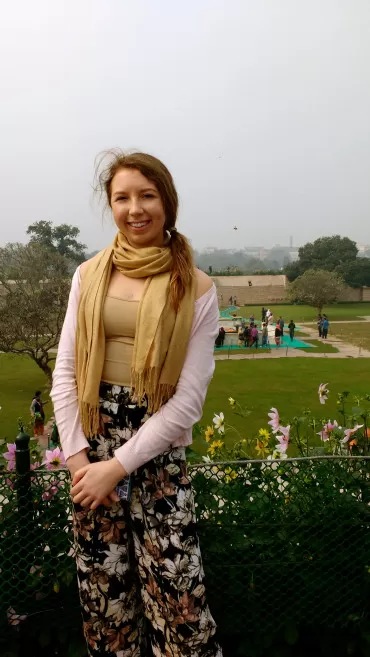
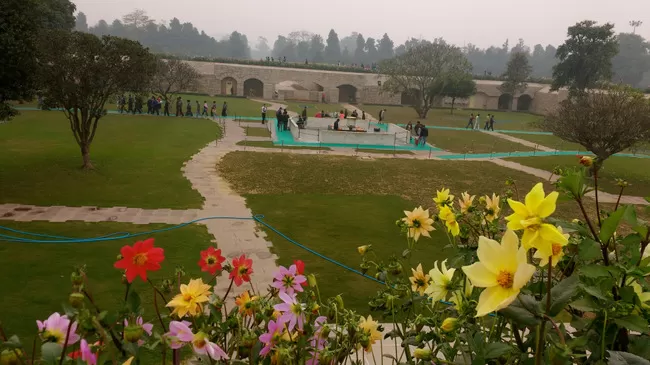
We subsequently moved on to Humayun's Tomb, a site in which many future architectural creations, including the great Taj Mahal, find their origin. This elaborate tomb complex was constructed in 1565 by the Mughal Emperor Humayun's widow, Hamida Banu Begum, nine years after his death, and was the first garden style tomb to be constructed in India. The tomb stands in the centre of vast, Charbagh-style Persian gardens, split into perfectly symmetrical segments, and linked by channels. This deliberate geometrical scheme consisting of four identical parts separated by wide paths and flowing channels (representing the river of Paradise) served as a powerful metaphor for the Paradise Garden.
The first of its kind, Humayun's Tomb went on to serve as the prototype for many other Mughal tombs, on which similar techniques were employed, such as the use of red sandstone, the central building's octagonal shape and its high central arch. The very idea of constructing a mausoleum in honour of a loved one is the central foundation stone behind the creation of the Taj Mahal.
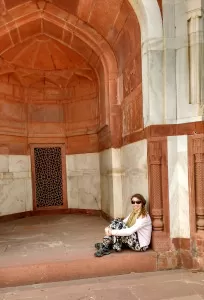
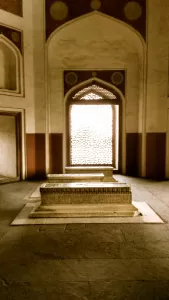
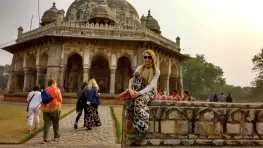
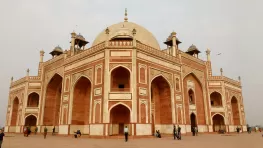
The last stop on the itinerary for that day was the Qutb complex, which was constructed by Qutb-ud-din Aybak, one of the founders of Muslim rule in India. It was built in the early 13 th century and comprises funerary buildings, two mosques, and the Qutb Minar, a 72.5m-high minaret. The Quwwatu'l-Islam mosque is the oldest in northern India and was made from materials looted from around 20 Brahman temples. Some of the stones bearing religious icons have even been inserted upside down in a clear manifestation of the new rulers' derision of their Hindu enemies.
Before making our way back to the hotel, we drove through New Delhi, which was built as the imperial capital of India under British rule and completed in 1931. A stark contrast to Old Delhi, this part of the city is all wide, tree-lined avenues, parks and fountains, and has a comparatively European feel. We took a drive through Connaught Place (Rajiv Chowk) and Connaught Circus (Indira Chowk), which form the business and tourist centre. In addition, we stopped to take a look at governmental buildings such as the official residence of the President of India, which stands at one end of Delhi's famous boulevard, Rajpath. At the other end stands the impressive 42m-high India Gate, one of those 'Arc de Triomphe' constructions that seem to pop up everywhere, which commemorates the Indian soldiers who fell in WWI.
That evening was our Namaste dinner, which consisted of many courses of traditional Indian food - bhutta palak (creamed spinach), paneer makhani (curd cheese), mushroom matar, jeera aloo (lightly fried caraway-seasoned potatoes) and dal tadka (spiced yellow lentils), served with naan bread, of course. We were also treated to an Indian dessert, gulab jamun, a sickly sweet donut-like creation, made from khoya (a mysterious dairy product) fried until golden and finished with a touch of saffron.
After the meal, it was time to head back to the hotel - and time for a quick reminder of the fact that we were staying in what I can only presume to be one of the most chaotic cities on earth. It's lucky I'm used to and can accept that, when you're travelling to far-flung places, things might not necessarily meet your high standards of Western living. For example, after living in Peru and washing in cold water for a month, I now consider hot water a blessing, rather than a given. It was therefore not the end of the world when we'd arrived in Delhi in the middle of the night only to discover that the hot water was turned off between the hours of 11pm and 6am. Unlike many fussier travellers, I also accept that, in a place like Delhi, which is so pushed for space, it would be unrealistic to expect a room with a view or, indeed, a room with a window at all.
In a similar vein, I was about to discover that, Delhi being so full to the brim, and the hotels built so compactly, this also meant that the hotel conference room would be located directly above the third-floor rooms. This is all very well and good when the hotel is hosting, say, a conference, in the middle of the day. When it's hosting a party in the middle of the night, not so much. After a long, jet-lagged day, I was just drifting into a lovely sleep when I was jarred awake by what sounded like an earthquake going on right above our heads. Had the music been pleasant, the situation might have been bearable, but the fact was, this was far from being a soothing melody to lull me to sleep. No, this was relentless bass, so loud it shook the very walls of our little windowless cell of a room. The melody line was just strong enough for me to make out, at one point, the dulcet tones of that Daddy Yankee reggaeton classic, Gasolina.
When Laura and I went down to reception, bleary-eyed, confused and dismayed, the men at the desk just looked at us with expressions of mild amusement and told us it would be over in "about half an hour". Naturally, there was no chance of switching rooms as they were all allegedly booked up. We had no choice but to trudge dejectedly back to our room, wait for our room to stop shaking and wait for that long-awaited sleep to come.
On Day 3 we embarked on the long and arduous journey to Jaipur - which, although only a 250km drive, took us over five hours due to the horrendous traffic on the roads out of Delhi. After stopping off to pay the municipal road tax - which involved our driver risking life and limb in an epic sprint across the five-lane motorway - it was a good two hours before we were away from the city and properly on our way.
It's no mystery why they call Jaipur, the capital of Rajasthan, the Pink City - the whole place is bathed in a striking coral colour. Originally painted pink, the colour associated with hospitality in India, to welcome the Prince of Wales (later King Edward VII), the tradition has lived on, and so, therefore, has the city's nickname.
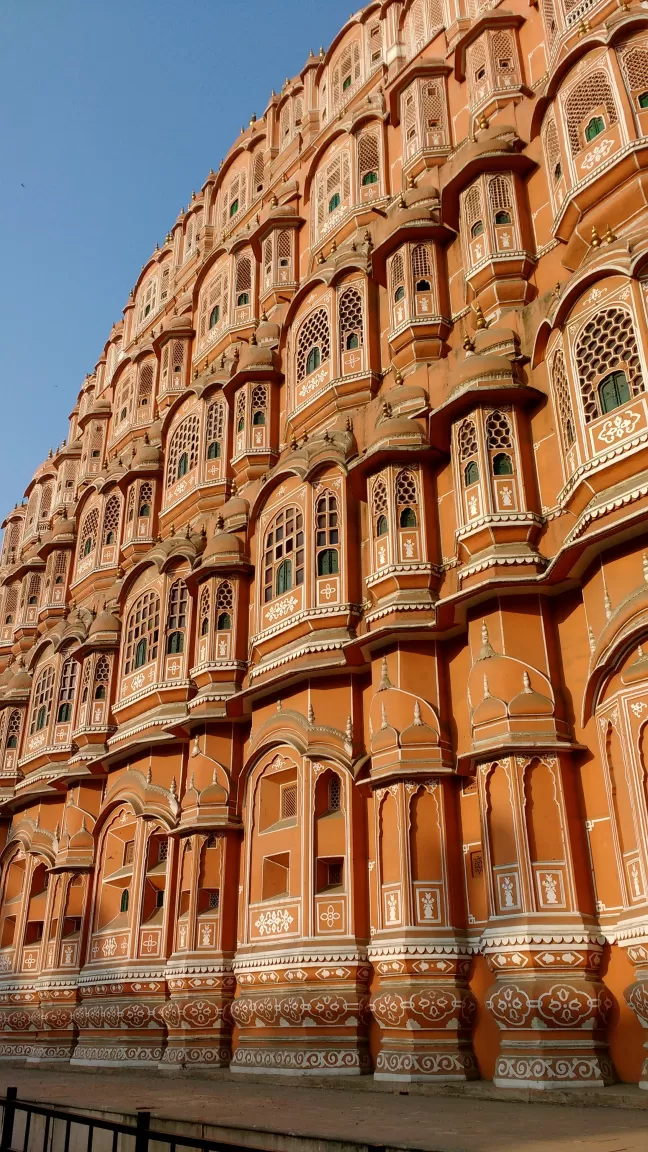
We'd been led to believe that, as traffic laws in Jaipur are tighter than in Delhi, the roads would be less chaotic. There seems to be a more civilised lane system, helmets are compulsory for motorcyclists, and carrying babies on motorbikes is prohibited (much to the relief of everyone on our tour bus). However, none of us had been fooled into expecting anything even vaguely resembling the orderly traffic system we're used to back home - spotting cows, donkeys, water buffalo, monkeys and even camels on the side of the road had become commonplace by the end of the day. It's amazing how quickly you become accustomed to seeing such bizarre scenes after just a few days in India; you become remarkably desensitised to seeing people pissing in the street, washing themselves with buckets of water by the side of the road and playing cricket in barren areas of rubble, rubbish and dirt.
And yet, despite the grim realities of city life in India, the people seem (for the most part) relentlessly positive in their outlook and spirit. They are staunchly religious - a fact emphasised by the sheer number of beautifully preserved temples, and the respect they show for what they regard as a holy animal, the cow. It's not uncommon to see people feeding pigeons, monkeys and other animals in the street, despite the abject poverty they face themselves, as this is believed to award the giver positive karma.
After a brief stop at the Hawa Mahal (Palace of the Winds), a five-storey building overlooking the city's main street, we headed straight to the City Palace, which comprises an artistic blend of Rajasthani and Mughal architecture. When we were there, the flag was flying, an indication that the Maharaja is in residence. Though no longer funded by the state, the royal family of Rajasthan still reside at the lavish home that has been passed down to them from generation to generation, and now make their living from the entrance fees paid by visitors to their various royal properties. Visitors aren't permitted access to the buildings where the family lives, but one of the palace buildings has been converted into a museum, housing art, carpets, clothing, jewellery and weaponry from generations past.
Crossing over the road from the palace, we visited the Jantar Mantar, the largest and best preserved of five observatories of astronomy built by Jai Singh in 1728. Thankfully we had an expert guide to explain the purpose of the gigantean stone sculptures, each of which had a different scientific function - to measure the positions of stars, calculate eclipses, or give the user the time and date. The complexity of some of the astrological instruments is astonishing, especially considering they were built over 200 years ago and remain accurate even today.
That night we stayed in a beautiful white haveli overlooking Jaipur. Standing on the balcony, overlooking the gently lit courtyard below and watching the sun go down over the city beyond, was one of those truly idyllic moments, which neither words nor photographs can capture.
Of course, where there are tourists, there is always an opportunity to sell something in India, whether that be a useless souvenir, a display of snake charming or even, that evening, a puppet show. Laura and I had just made our way down the steps to get a drink on the courtyard with some of the other girls, when we were all ambushed by an elderly Indian man brandishing an elaborately decorated wooden puppet held up by strings. With false promises that watching his show would be "free" (we'd heard that one before, and experience had already proven that nothing was free in this country), he ushered us over to a makeshift viewing area set up with a small line of chairs.
Before we knew it, his two young 'musicians' had launched into drumming and singing, and the show was beginning. "Well, at least they got to see something cultural," you must be thinking; don't be so sure. Imagine the hilarity when, of all the songs in all the world, they broke into Me gustas tú by Manu Chao - the very song I'd oh-so-randomly been listening to on my sad old iPod that day! Even better was the fact that they seemed to know only one line - ' me gusta la marihuana, me gustas tú' ('I like marihuana, I like you').
As if Laura and I weren't already hysterical enough, the puppeteer, after spending a couple of songs waving his puppets around in a nonsensical fashion to an unpleasantly high-pitched whistling sound, took out what he called the 'honeymoon' puppet. "Oh, how romantic," you might be tempted to think. Oh no. What ensued was the most horrific display of what can only be described as 'puppet porn' that I hope I am ever likely to see. This particular puppet essentially consisted of two dolls - a husband and a wife - attached together, so they could perform a variety of sex positions, much to the astonishment of the unsuspecting audience. Missionary, doggy, pinwheel, octopus... every trick in the sexual handbook: an experience so surreal we were still reeling after we'd handed over, dumbstruck, our 100 rupee tip. Not quite the idyllic end to the evening we'd been expecting, but certainly an experience.
The next day, after a most unwelcome wakeup call to prayer from the nearby mosque at 5.30am, we dozed for an hour or so before setting of to the Amber Fort (pronounced 'aa-mer fort'). After a brief stop-off at an ATM (a detour that had to be planned in advance, as it's so difficult to find ATMs in locations where our coach was able to stop), we were on the road.
Our first glimpse of the fort was from the road, and gave us a breath-taking first impression of its majesty. The high, sandstone walls span the length of the hillside above, and the fort itself looms imperiously over the Maota Lake below. At that early hour, the soft light of the morning sun was playing gently on the mirrored surface of the lake, and the fort itself cast a faint golden glow on the water.
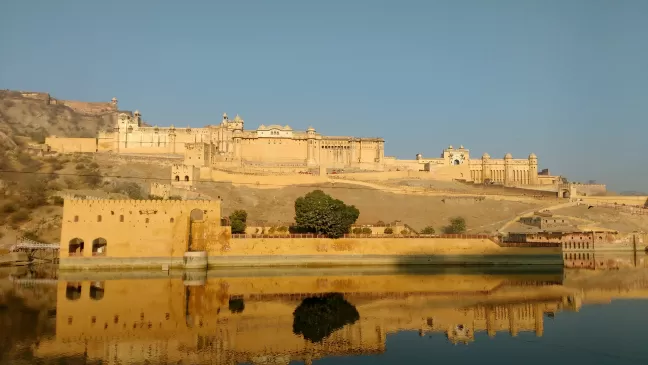
As we stood to queue up for the day's main event, the elephant ride up the stone path to the fort complex, we began to take in the beauty of our surroundings. (Or, at least, we did when the swarms of looky-looky men, trying to peddle us crappy souvenirs at outrageous prices, weren't harassing us. They've clearly grown wise to the fact that any keen tourists wanting to enjoy this unique experience will have no choice but to arrive early and wait in this enormous queue - as, since an unfortunate accident with an angry elephant a few years ago, rides are now restricted to three a day per elephant).
This was my second time riding an elephant, but no less exciting than the first. I don't know whether it was just my memory playing tricks, but the elephant I'd ridden in Thailand had seemed considerably smaller than this one; this time, the most difficult aspect was trying to stop myself sliding around on the cushioned platform on the elephant's back, on which Laura and I were sitting side-saddle, our legs outstretched and feet hanging off the end. Ascending the steep stone slope to the fort on the back of an elephant gave us a stunning aerial view of our surroundings and an impression of what it must have been like to enter the fort as royalty in centuries past.
The fort was originally built by Meenas and later ruled by Raja Man Singh I. It was constructed in a Hindu architectural style, in the characteristic red sandstone and marble, and is split into various sections, the most important of which being the Diwan-e-Aam (Hall of Public Audience), the Diwan-e-Khas (Hall of Private Audience), and the Sheesh Mahal (mirror palace). This last, a stunning room built entirely of marble and precious stones, is particularly interesting, as it served as the prison of Shah Jahan, after his own sons took him captive to prevent his excessive spending, which was sending the country into ruin.
The fort, being the former residence of the Rajput Maharajas and their families - including entire sections just to house the Maharajas' large harems - is therefore often also called a palace, and is joined to another fort located immediately above it, on the same Aravalli range of hills, called the Jaigarh Fort. The two are connected by a subterranean passage intended as an escape route in times of war.
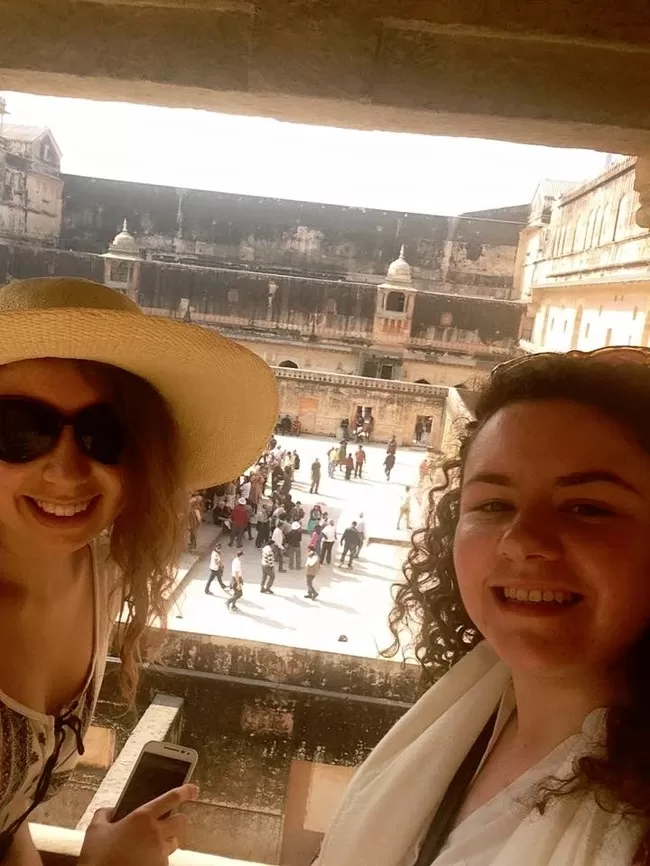
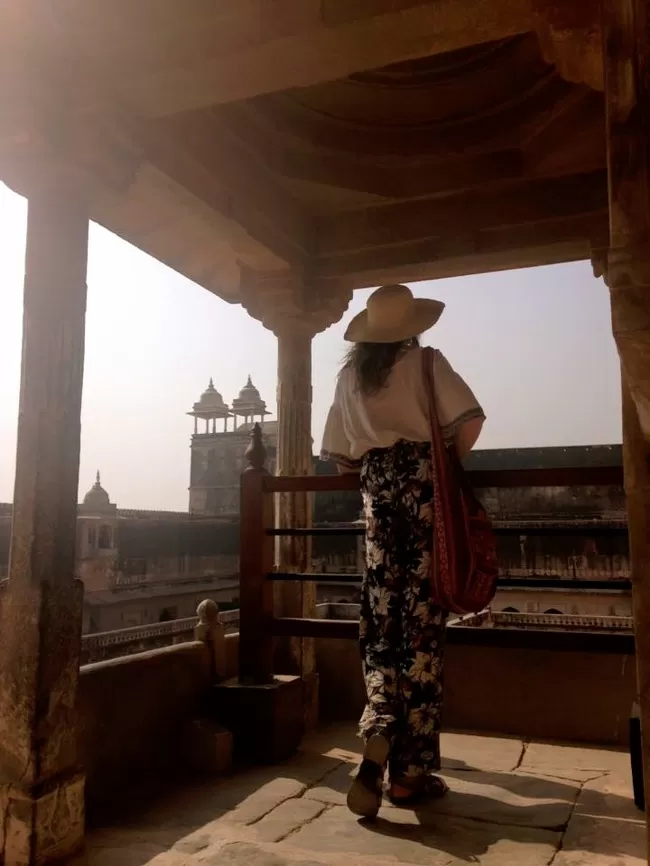
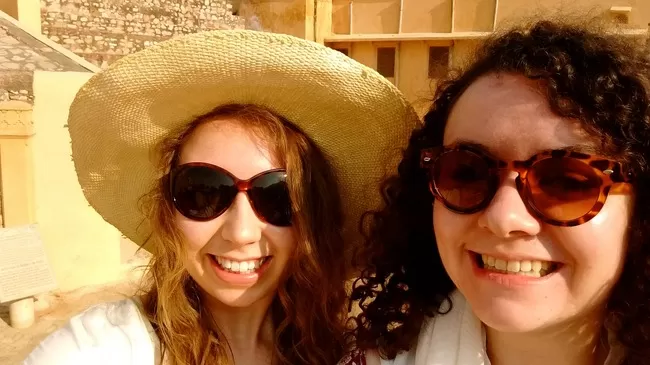
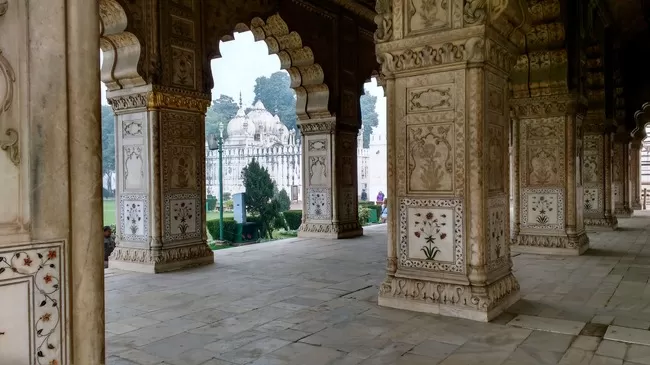
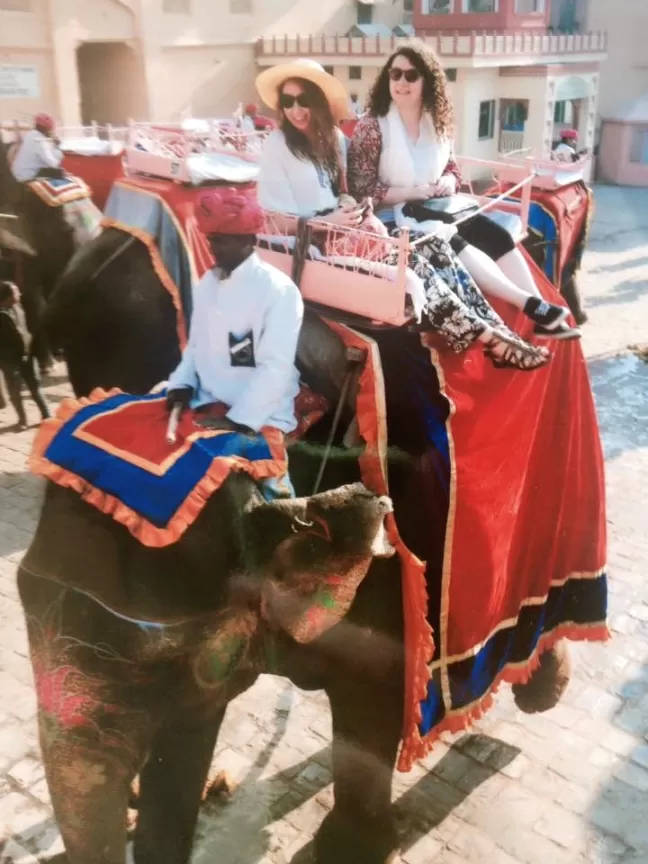
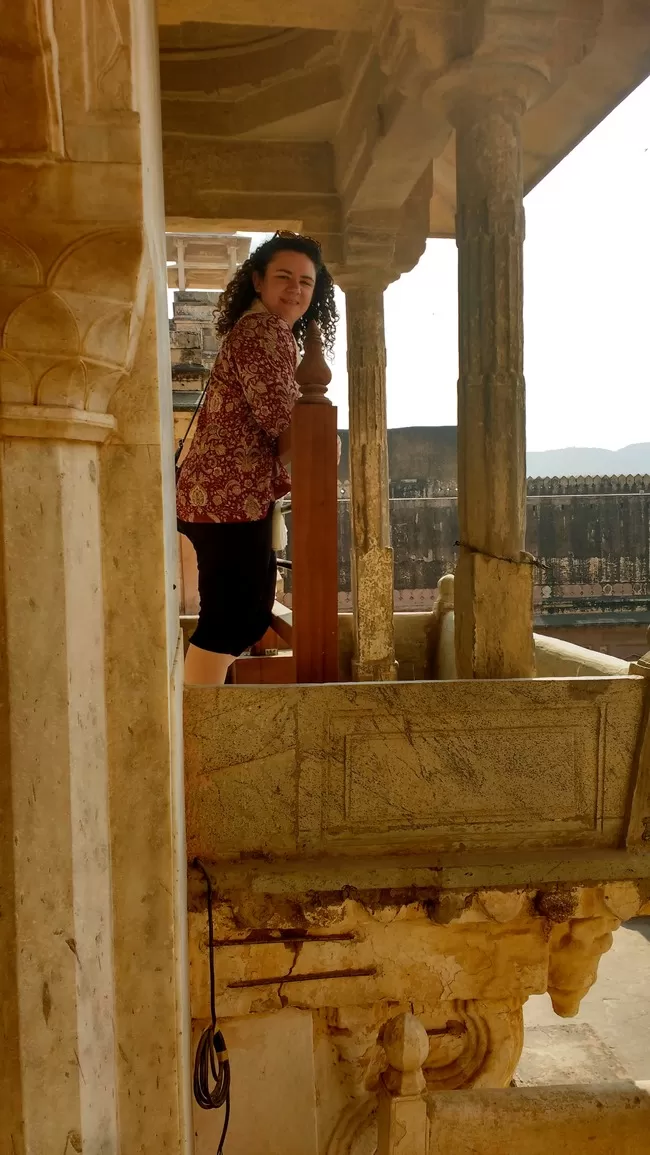
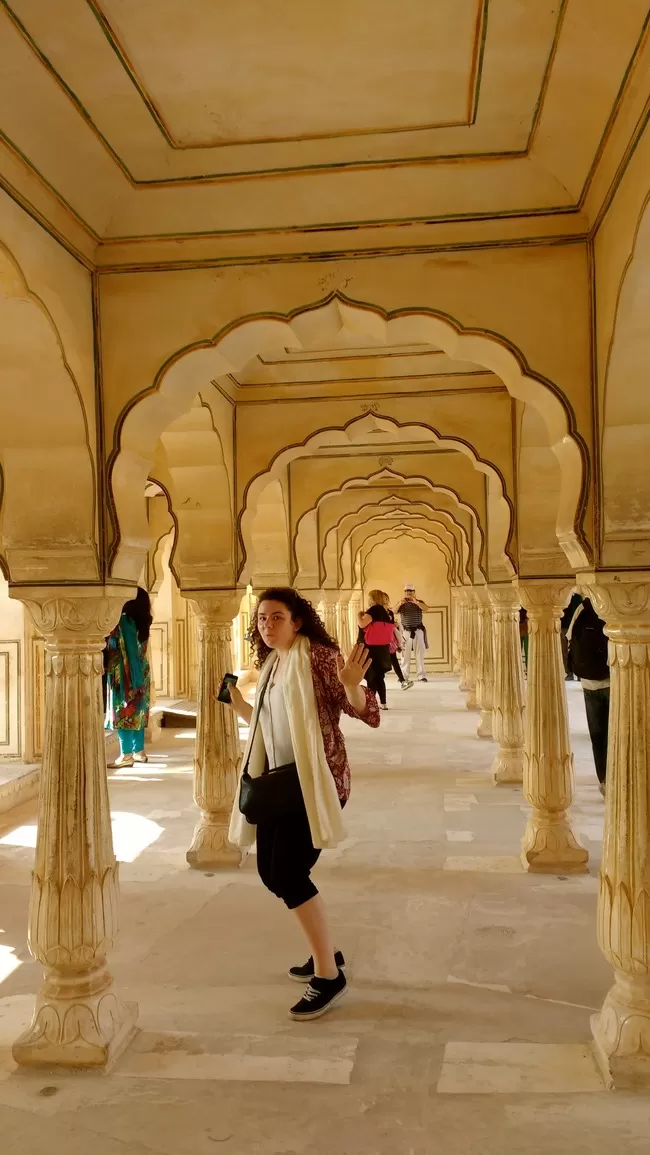
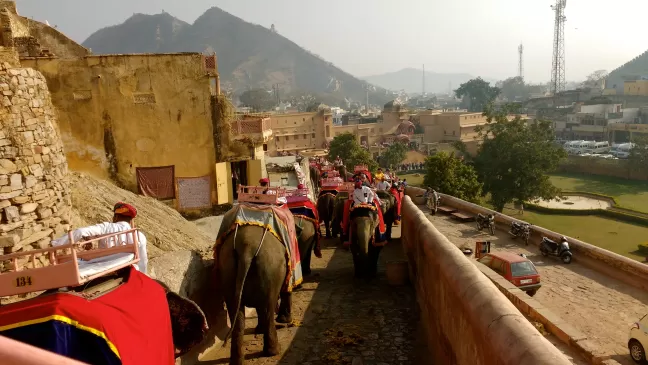
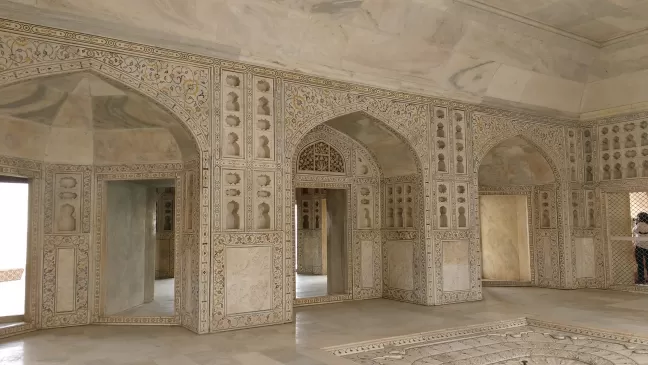
After a detailed tour of the fort, we were taken to a traditional local cotton trading and tailoring factory. There we were shown the process behind block printing on fabrics and carpet weaving. All the carpets and fabrics sold by the factory are still produced by the descendants of those who worked for the factory when it first opened, although many families work from their own homes and simply deliver the finished products to the factory. The work is so intricate that it's easy to see why hand-weaving just one carpet can take over a year.
We were invited to watch a demonstration of the printing process, and naturally, I was the one selected to give it a go. At the end of the demonstration, much to my surprise, the man gave me the elephant print I'd made, telling me that I could get anything I wanted with my smile. What a charmer!
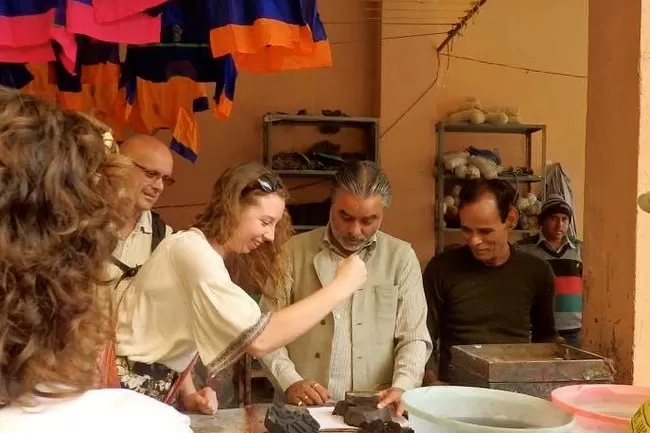
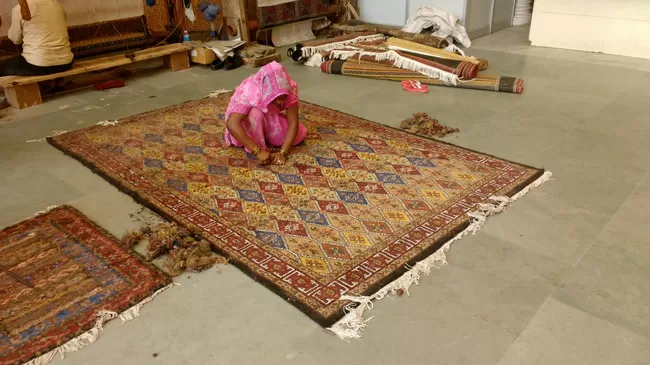
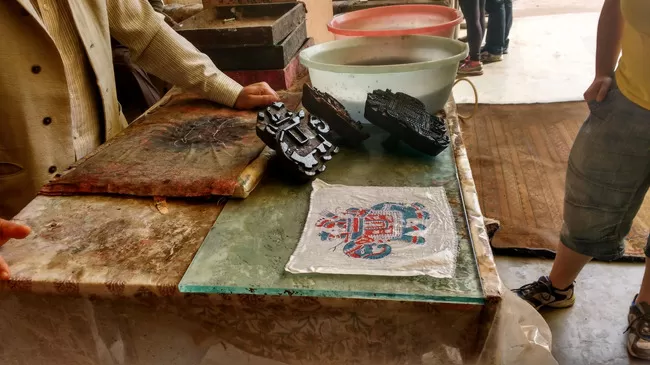
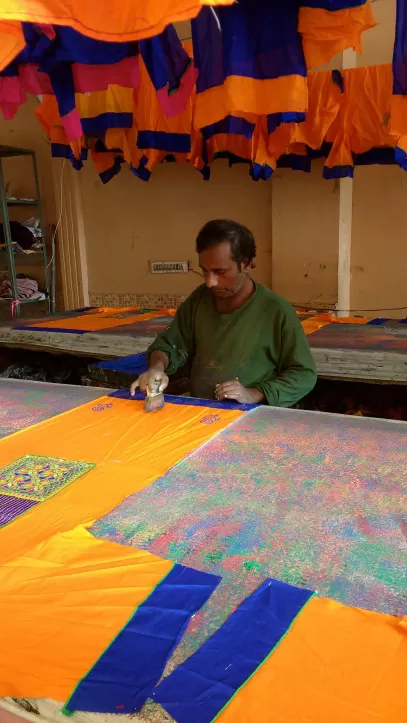
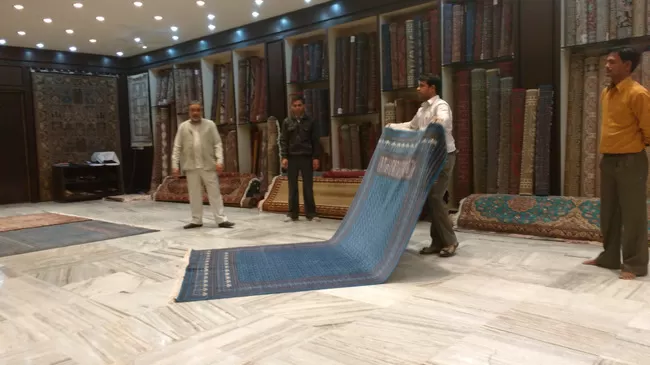
We were then showed inside and offered local rum whilst they put on an elaborate show (i.e. sales pitch) of all the different sizes, patterns and qualities of carpet they had on offer. I suspect that the rum was part of their ploy to get us to purchase an obscenely priced rug that no one could possibly want or need in a normal modern-day home, but I figured no amount of rum could get me drunk enough to induce me to buy one, so it was safe to guzzle away. One Canadian couple did actually end up buying a carpet worth around £3000, which would be waiting for them upon their return to Canada. This made me feel slightly better about drinking these people's rum knowing full well I wouldn't be making a purchase.
After lunch in the green courtyard of a lovely little restaurant, we made our way to the last stop on the itinerary for that day. This was a tiny little gem 'factory', which actually consisted of around twenty employees. We were ushered into the first room, which was essentially a converted garage and, now that I come to think about it, was a pretty strange place to manufacture such valuable goods. There, around eight men were sitting cross-legged on the floor, and a further four at a work bench, doing meticulous work on precious and semi-precious stones to chisel them into the desired shapes for pendants, rings and bracelets.
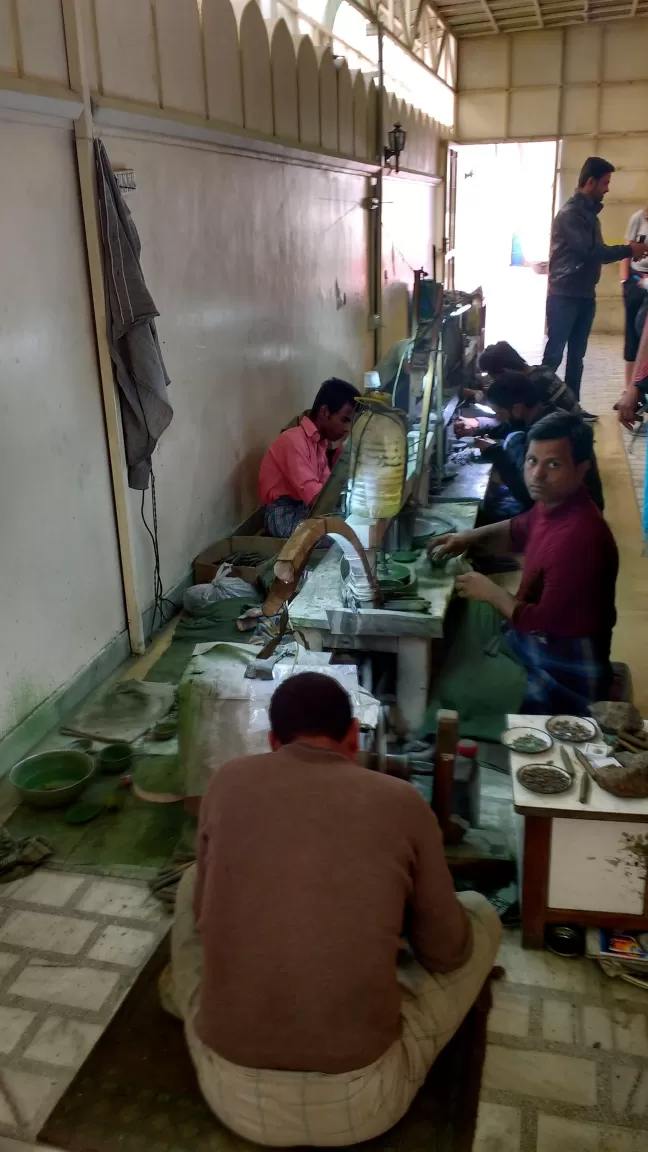
We were then inevitably shown into the two-storey shop behind the factory, which was a world apart from the room we had just left. We could have been in any jewellery shop in the world; the items were all stored neatly in polished glass cabinets, organised according to price and arranged in such a way as to instantly attract a tourist's inner magpie. Laura and I ascended the stairs immediately to the silver room (gold was downstairs) and began nonchalantly perusing the collection.
I'm not sure how it happened, but half an hour later I emerged from the factory, proud owner of a beaming smile and a beautiful sapphire ring. To my credit, I'd bartered the guy down from 7,500 rupees to 6,000, which isn't bad in an actual shop, I think. I got an official certificate stating that my ring was made from silver and Indian sapphire, and everything! I'd seen it and fallen in love with it, and when I'd told the guy my budget he'd tried to offer me alternatives - but my heart was set on that one. I was glad I'd stuck it out.
After this unexpected turn of events, which had led me to spend about £65 more that day than originally planned, it was time for yet more shopping opportunities. Those who were interested were dropped off at Jaipur's biggest bazaar, which sells all the cutesy little Indian souvenirs you could ever dream of. Admittedly, it was a bit of a culture shock, yet again, and I did feel slightly panicky at the sheer volume of people, things, random livestock and vehicles whizzing past, but I also figured that experiencing an Indian bazaar was something I couldn't leave without doing. An intensely alarming incident occurred when we were squeezing our way through a particularly dense crowd, and a man literally grabbed my crotch - I mean, he got his hand right in there. I was so dumbfounded that, by the time I'd registered what had happened and prepared to give him a wallop around the face, he'd disappeared into the crowd. It was several minutes later before the crowd had thinned enough for me to slow down and tell Laura that I had just been momentarily sexually harassed by a complete stranger. I mean, people taking photos of me without my permission was creepy enough, but this was just a step too far.
Thankfully I managed to survive the rest of the afternoon without getting groped, and none of us was robbed, which was a miracle in itself considering that we appeared to be the only white people for several miles around. We even succeeded in bartering our way down to some pretty decent prices, and I came away with some elephant earrings and some elephant trousers (well, when in India...), all for under £3. To get back, Laura and I grabbed a motor rickshaw with our new friends, Jan and Les, who are possibly the most awesome, go-getting retired couple I have ever met. Some of their top over-dinner anecdotes include the time their passports and worldly possessions were stolen on the South African border, and the time they spent the night in a Zimbabwean prison, due to a misunderstanding about drugs.
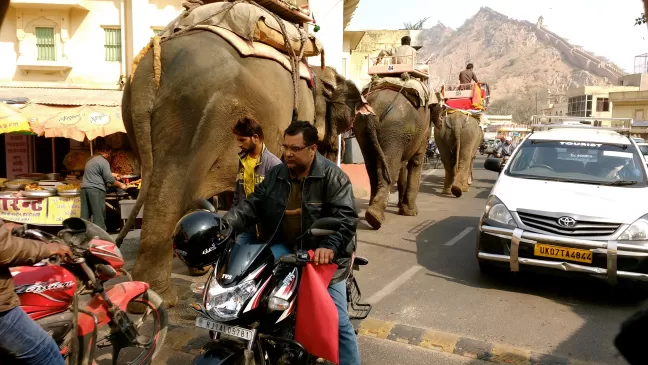
It turns out that the reason we'd been able to barter down our rickshaw driver to such a low price was not, in fact, down to our haggling prowess, but rather, the fact that said rickshaw was actually designed for two people, and not four. Driving around the streets of Jaipur, head pressed to the ceiling of a rickshaw and sitting across my friend and an elderly couple, who noted generously that my bum was 'a bit bony', has to go down as one of the more surreal moments in my life.
When we finally, after a lot of confusion and several illegal U-turns, made it back to the hotel, in one piece though a little bruised, it was almost time for dinner. But not before we'd been visited by the local henna expert, a sweet little lady in a sari who'd come with her daughter to do paint henna on those of the group who wanted it. I'm pretty sure we were a bit ripped off, as I've been able to get it done in the UK for cheaper, but she was obviously a bit of a local legend as she kept trying to show me her little portfolio of newspaper clippings about her. She'd been doing it for twenty-five years, and probably made more from us tourists in that session than she could otherwise make in a week, so I don't mind if we paid a little over the odds. At the end of the day, I wasn't really going to miss that extra fiver, but to her and her daughter, it was probably a lot of money.
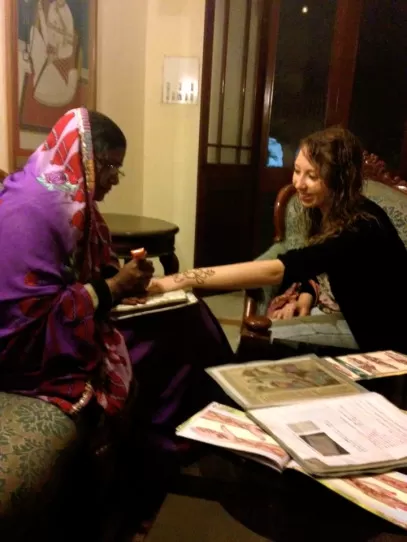
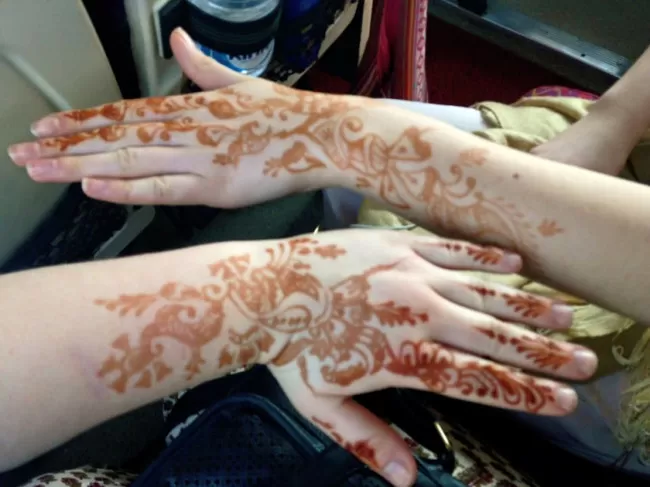
Looking all authentic (or rather, looking like some pasty tourists who were trying, but failing, to blend in), Laura and I went up to show the rest of the gang, who were just gathering on the terrace with yet more rum, to celebrate Kay's 60 th birthday. The conclusion I'd been coming to throughout the course of the week was confirmed to me in that moment; it was absolutely and completely irrelevant that Laura and I were a good twenty years younger than most of the group; they were a really great bunch of people - diverse and interesting and funny - and it was a pleasure to be sharing this experience with them.
I get my fortune told and experience village life
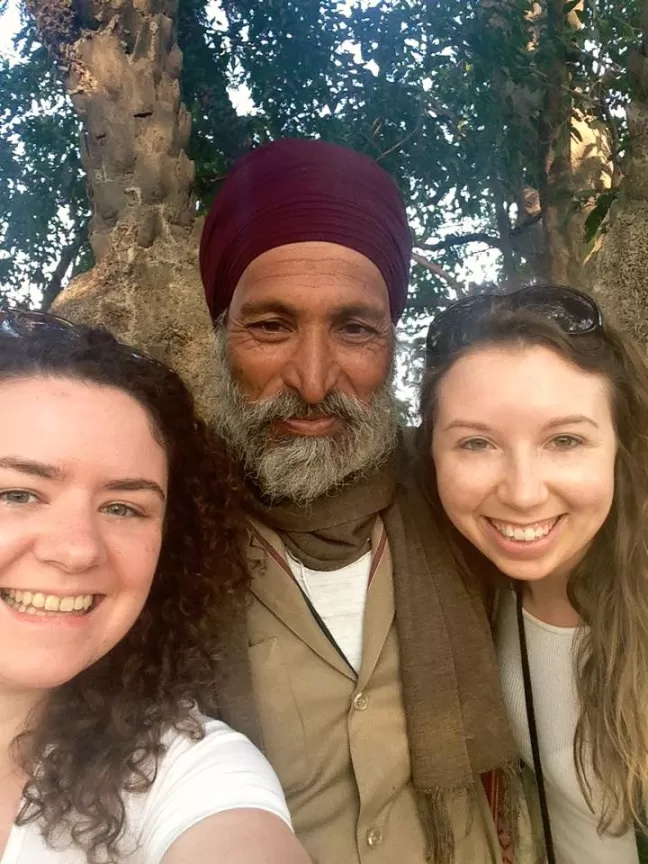
The next day, I somehow managed to sleep through the 5.30am call to prayer (the first time in my life I've ever managed to sleep through any kind of noise, ever) but was called down to reception before breakfast, as I'd organised to have my fortune told. I, like most people, am skeptical of this kind of thing but, having heard a lot about the fortune tellers of India, considered it another one of those things I should try whilst I had the opportunity.
The night before, I'd been asked to write down my full name, as well as the date, time and location where I was born. Using this information, the fortune teller would be able to work out the star alignment the moment I was born, and from this, map out the story of my life. I'm not sure what I'd been expecting, but I wasn't surprised to find an elderly, turbaned man with a grey beard awaiting me in the courtyard. What did surprise me was the small A4 portfolio he had with him, bearing my name in printed letters on the front page and containing a detailed breakdown of my personal characteristics and fortune within.
Now, I'm sure that everyone believes they're self-aware and objective, although the latter, if not the former, is physically impossible as a human being. However, I think I'm smart enough to recognise that it's easy to make false connections when someone is telling you something you want to believe - why else would religion be such a successful scam? It was therefore with a pinch of salt that I listened quietly to the information relayed to me by this stranger who claimed to have the power to see into my past and future. For the sake of intrigue, I will nevertheless pass on to you some of the information that I found most interesting:
'Her mental ability will be prominent and her brain will have both masculine and feminine trends of thought'.
'She will be interested in many different subjects - therefore she will be curious about all the knowledge and science of the world'.
'She will be skilled at liaison work, will be involved in mediation'. A born project manager? I hear you cry.
'She will be interested in singing, in music'.
'She will be self-critical and in other words she will destroy her own image'.
My biggest talents are allegedly 'awareness and curiosity'
My biggest weakness, 'liveliness or instability'
Between the years 2000 and 2018, my main struggle has been/is/will be with self-confidence. He kept stressing that I need to conquer this. It was a little spooky.
I'm a highly lucky person. Woohoo!
From 2018 to 2034 will be my 'golden years', where I'm the most successful and happiest in my personal life.
I will have many lovers (shh, all of you, no sniggering), but I will get married when I eventually choose to settle down. In the end, the path of stability will be my path to happen.
My most compatible lovers are Libra, Leo and Sagittarius, but I should be wary of Leo, as my relationships with Leos will be too passionate, and thus, self-implode. (Particularly spooky, that one, judging by two past experiences).
I'll have two children, both of them girls.
My lucky stones are emerald and diamond. For happiness in marriage, I should ask my fiancé to buy me a diamond ring. I kid you not, he actually said this (and I didn't manage to get it on tape).
It was a bit of a strange feeling to begin the morning this way and then proceed to go about my day as normal, but this is what I did. That day, we were moving on to Bharatpur, with a few noteworthy stops on the way. As ever, the journey itself was kept interesting by such sights as: a man bathing on the street, elaborate shrines and even a temple on the side of the motorway, and even some brightly-dressed women dancing in the street. When we got out to watch, they dragged Laura and me in with them, one of them even borrowing my straw hat.
We also stopped off at an ancient temple and an enormous well called the Chand Baori - not like any well you've ever seen, but the largest and deepest step well in the world. It boasts a staggering 3,500 steps and is 13 stories deep.
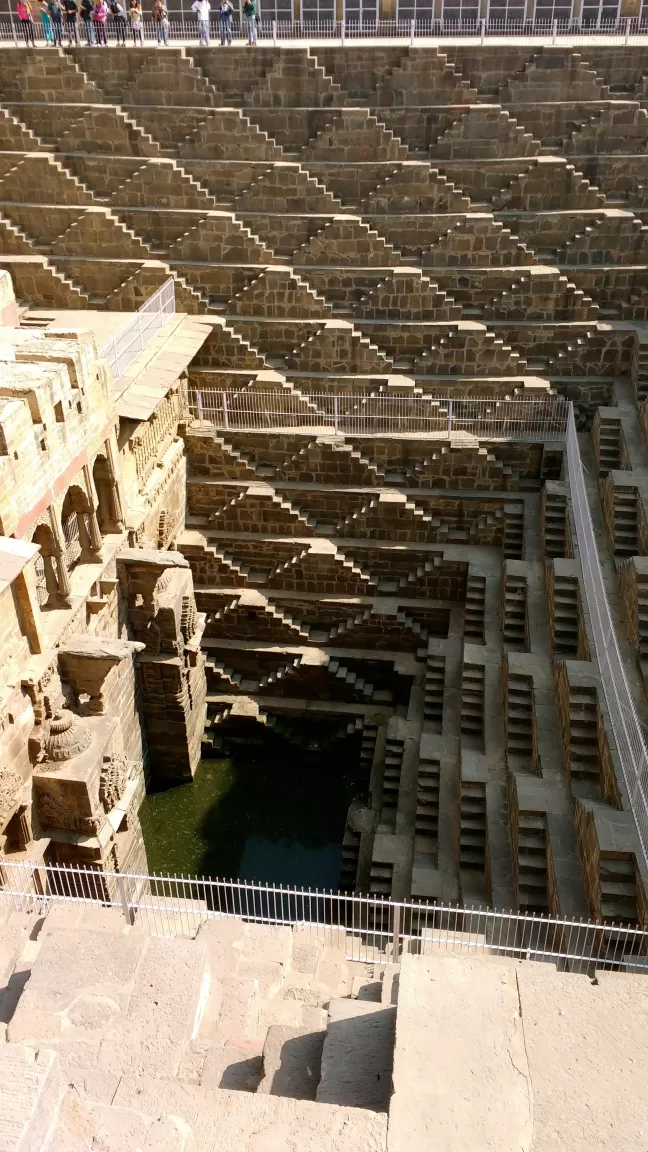
A visit to the local school Adarsh Vidya Mandir, was an eye-opening glimpse into the realities of Indian village life. Even with the help of the 'Change for Children' programme, funded by On The Go Tours, the school is a mere shell of a building. Comprising a small dirt courtyard, a closed room for nursery-age children and three open-fronted 'rooms' for the other age-groups, with no desks or chairs, there is still a long way to go. Thanks to donations from tourists like us, the school has recently been able to construct a girls' toilet at the back of the site - a huge achievement. The children were so excited to meet us - particularly the nursery pupils, who shouted 'Hello!' in tiny, high-pitched voices, waving furiously - that I felt guilty for not bringing more money to donate, because our meagre donations didn't seem to merit such a warm welcome. It made me wonder where on earth all the money generated by tourism, construction and commerce was going; but then I remembered - straight into the pockets of the fat cats who rule the place, whose goal is to keep the people poor and uneducated.
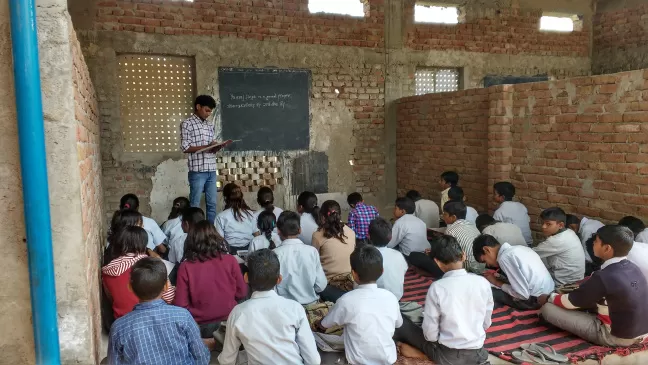
I digress. Anyway, our next and final stop was to Keoladeo Ghana National Park. A UNESCO World Heritage site, the reserve is home to some 364 species of bird, and formerly served as the duck-hunting reserve of the Maharajas. Nowadays, it is home to a wealth of migratory birds, including the Critically Endangered Siberian Crane, and is renowned as one of the world's most important bird breeding and feeding grounds.
Not being expert bird-watchers ourselves, it was lucky that Laura and I were given a cycle rickshaw tour guide who was a bit of an aficionado and could not only lend us some much needed binoculars, but was also pretty decent at spotting things (whereas Laura and I would have had difficulty seeing a bird even if it flew right into our face). The slightly batty old man had been working there for, as far as I could gather, his entire working life, but was clearly just getting into the wonderful world of selfies; he just couldn't get enough of them. I'm not sure what was more memorable about the afternoon - seeing some almost extinct waterfowl or taking selfies with a batty old Indian rickshaw driver.
On the final day of the tour, we were woken bright and early to travel to the city of Agra. On the way, we visited Fatehpur Sikri, the former capital city of the Mughal Empire from 1571 to 1585, when it was abandoned due to lack of water.
The site is divided into four main sections: the women's quarters; the emperor's quarters (which contains the tallest and widest bed I have ever seen); a quarter for prices and noblemen; and a quarter for housing weapons. The most interesting aspect of this site, to me, was the fact that, for each of his four wives, who each followed a different religion, the emperor had built in a different style. For example, the lodging of the Muslim wife was engraved with symbols from Islam; the Christian wife's quarters were decorated with crosses, etc.
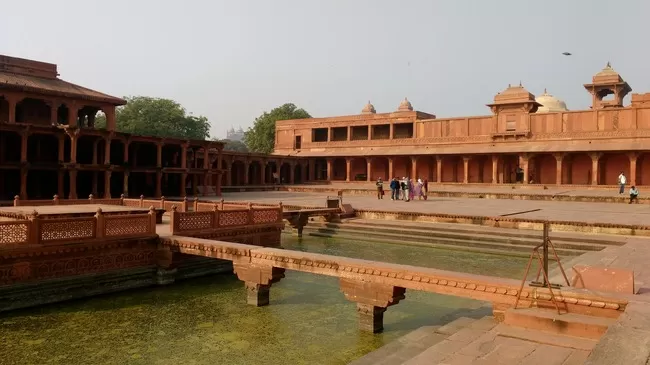
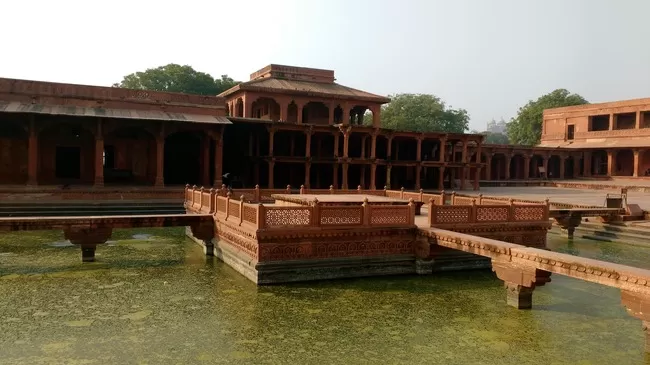
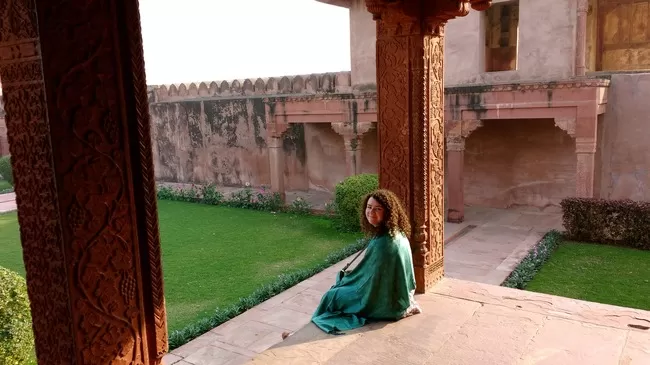
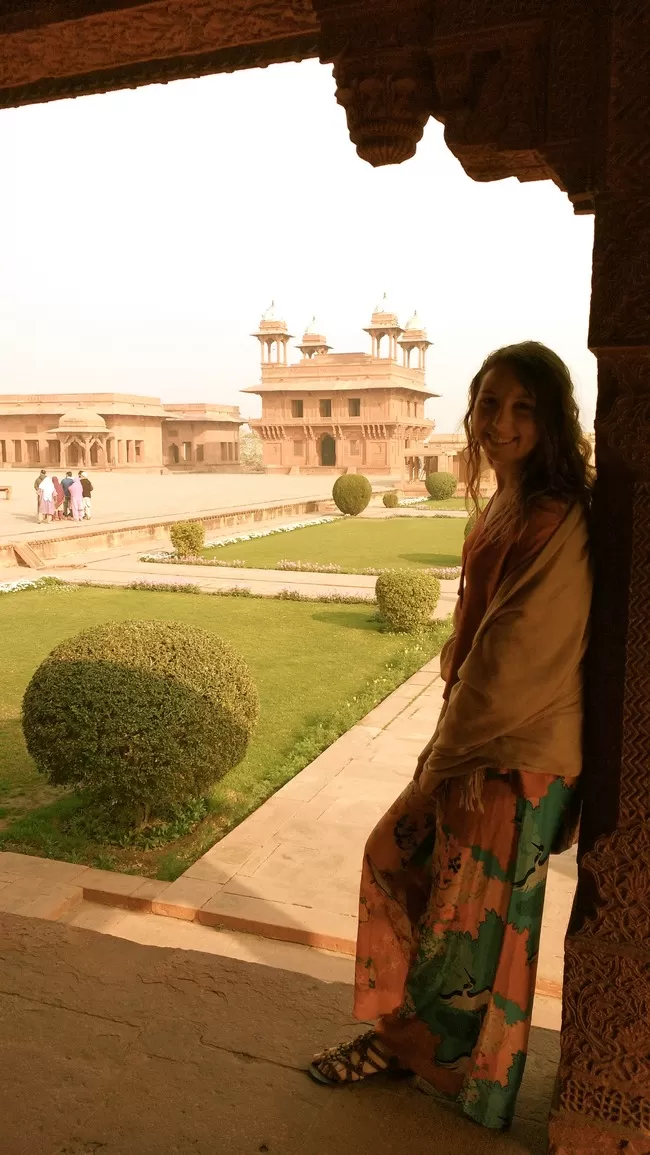
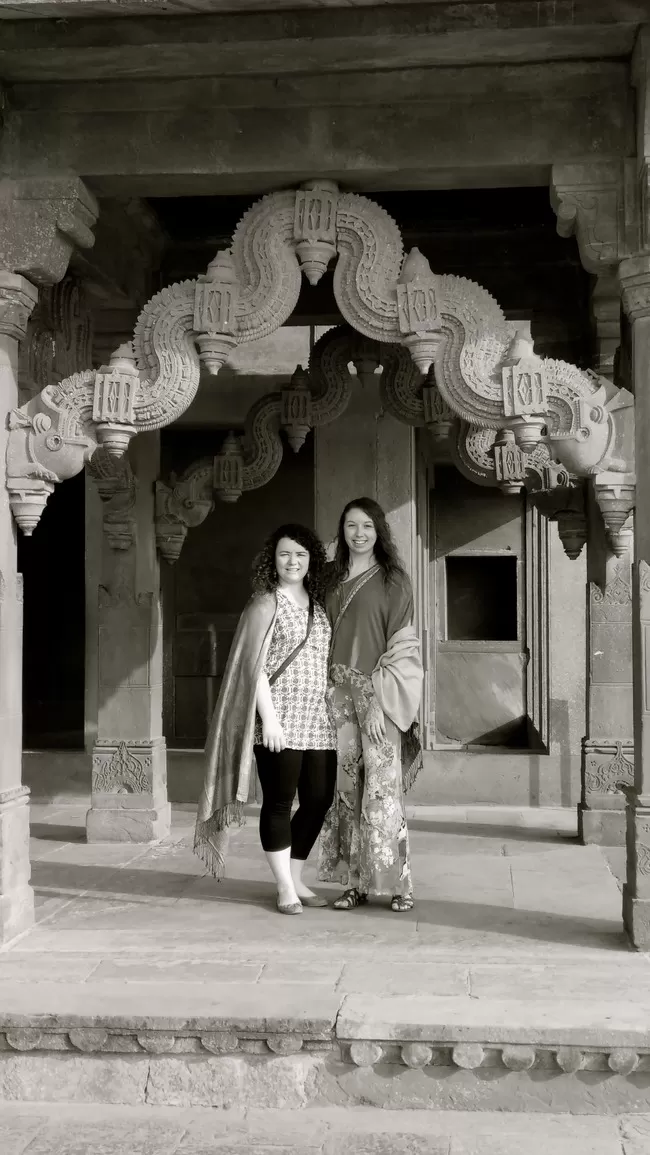
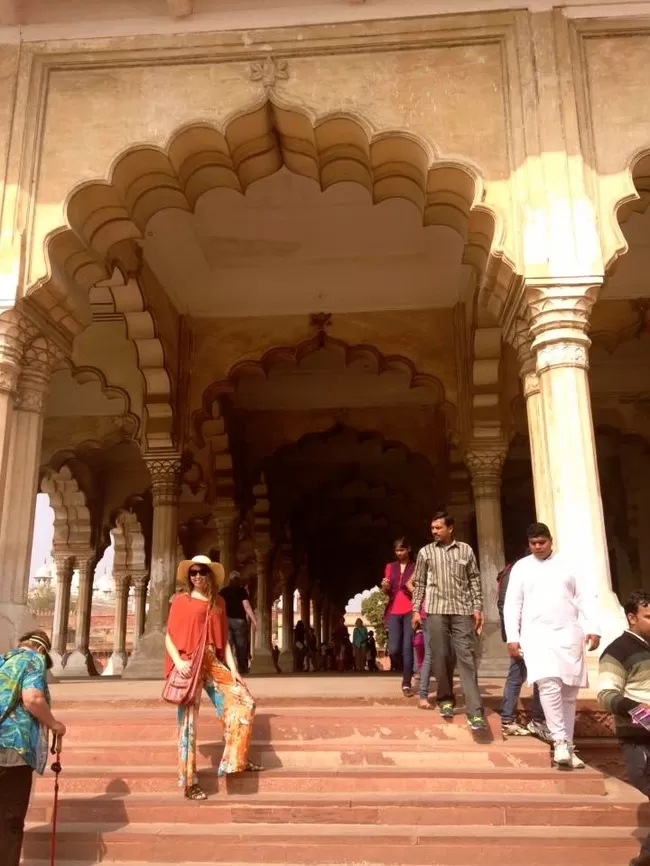
We then just had time for a short tour of Agra Fort, which was constructed under the reign of Emperor Akbar and extended under the rule of his grandson Shah Jahan. Originally designed as a military fort, it later served more as a palace, the evidence of which can still be seen today.
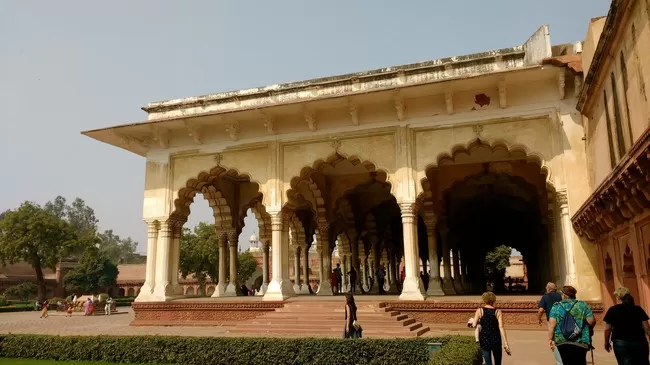
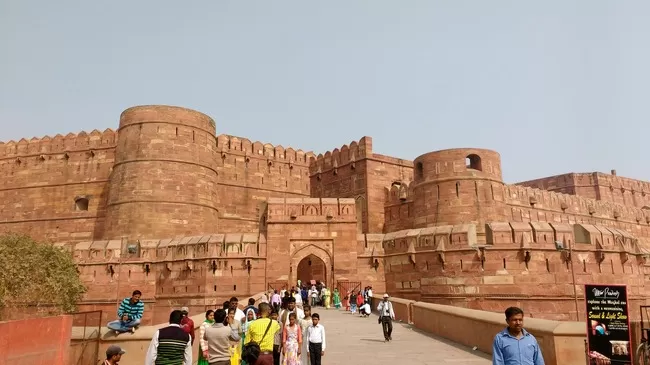
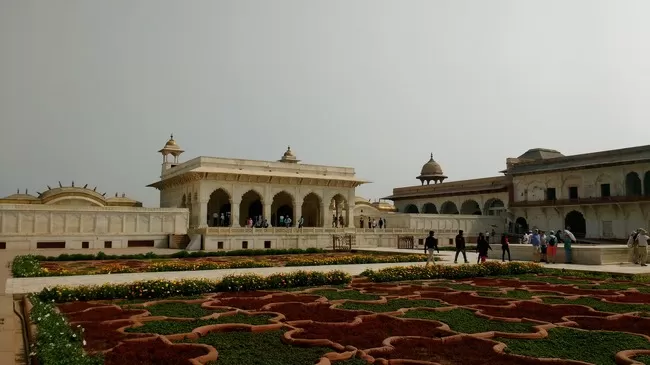
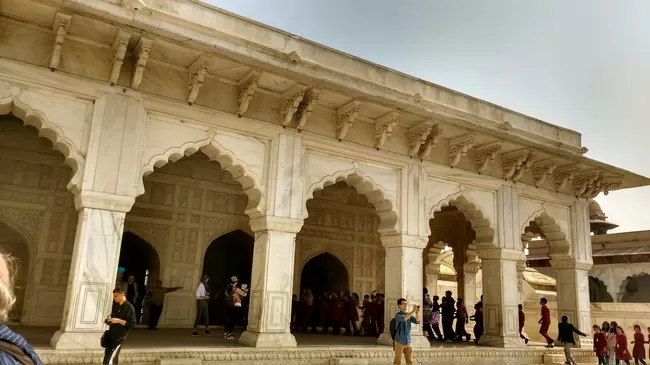
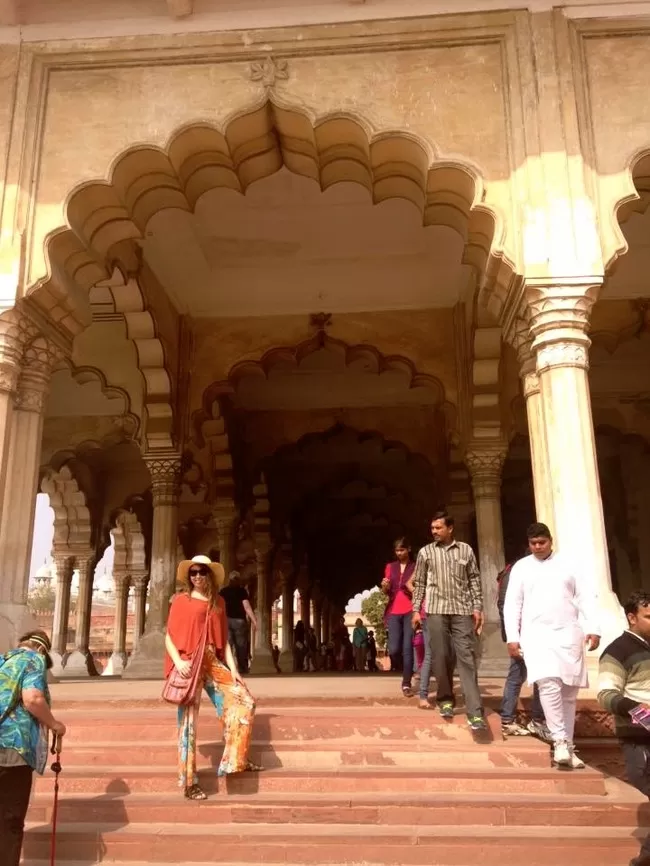
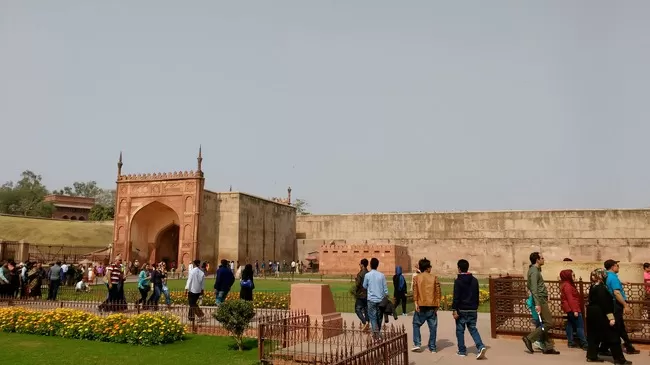
After a brief stop at our hotel in Agra to 'freshen up' (although why this was deemed necessary, I'm not quite sure - perhaps so the more glamorous among us could make themselves 'photo ready' for the Taj Mahal) we took the short drive to the Taj Mahal. The road leading to this famous mausoleum is so long that electric minibuses are usually in operation; however, typically, they weren't running at the time we arrived, leaving us to make the journey on foot. It wasn't actually long enough to elicit the use of vehicles, in my opinion, but it was also that bit too far for poor Jan, who had gone over on her ankle that very morning. Luckily, the legendary Sat, our guide, had made contingency plans; before we knew it, Jan was riding off into the distance on the back of a moped, beaming from ear to ear.
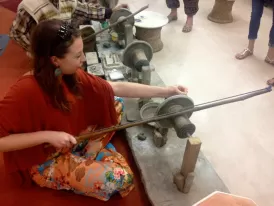
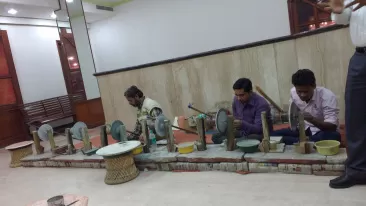
The workshop where descendants of those who worked on the Taj Mahal now carve precious stones and marble for commercial use
Surprisingly, there was hardly a queue to get into the mausoleum complex. The crowds only began to form as we turned the corner and approached the main archway, beyond which the mausoleum stands. The Taj Mahal, which took 22 years of labour and 22,000 workers to construct, is one of the Seven Wonders of the World. It is described as the most extravagant monument ever built for love, but the word 'extravagant' doesn't even begin to do it justice. I will never, ever forget the moment that whiter-than-pearl marble dome first came into view, framed perfectly by the dark sandstone of the archway. It was just so perfectly crafted, down to the visitor's picture perfect first glimpse.
The story of the Taj Mahal is thus: Shah Jahan, born Prince Khurram in 1592, was fourteen years old when he first met Arjumand Banu Begum, a beautiful Persian princess, who was fifteen at the time. He knew instantly that he wanted to marry her, and so they were eventually joined in matrimony five years later, in the year 1612. When Shah Jahan became emperor in 1628, he entrusted his wife with the royal seal, bestowing her with the title of Mumtaz Mahal, meaning 'Jewel of the Palace'. (Naturally, the Shah did have other wives, but Mumtaz Mahal was his favourite, and accompanied him everywhere, even on military expeditions). In 1631, however, their marital harmony was shattered when Mumtaz Mahal died giving birth to their fourteenth child. On her deathbed, she made her husband promise that he would never remarry, and that he would build something to show their eternal love. And this is how the Taj Mahal was born.
I've seen many impressive buildings on my travels, but never, ever, has one managed to take my breath away like this did. It's an indescribable sensation, impossible to put into words, but the Taj Mahal was not 'impressive' or 'imposing' or any of those words; it is simply sublime. Even as we were leaving, two hours later, I could hardly bear to tear my eyes away from the place; I wanted its image forever imprinted on my mind. It's a beauty to which photographs can't possibly justice, and which memory cannot possibly hope to recreate. It is truly spellbinding.
Days 7 & 8: Last Stop and Home
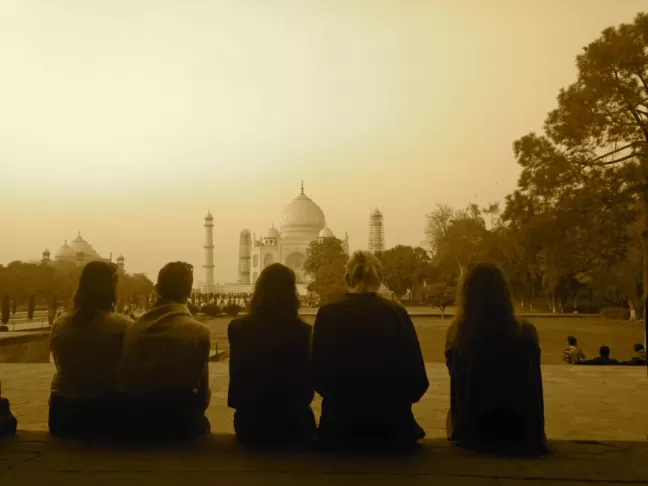
How fortunate that the tour had left the best until last, because I can't think of a single sight that could possibly follow the Taj Mahal and be anywhere near its equal in beauty and splendour.
The following day, we embarked on the long journey by road back to Delhi, where the tour group would spend our final afternoon before going our separate ways across the globe. Laura, some of the other girls, and I, made the most of the time by heading into the city centre to do some last minute shopping. We successfully managed to navigate our way across the city using the metro system, and no one was abducted, robbed or killed, hoorah! We all came away with bags of loot, spending our last rupees, which tourists are prohibited from taking out of the country. I even managed to get my hands on an embroidered cotton bag, something I'd been keeping my eyes out for the entire trip; it had paid off to hold out.
There's not much more to say except that the trip came to a pleasant close, with many hugs and kisses goodbye, and promises to stay in touch. A spontaneous whim to fulfil my dream, following a friend on a whirlwind tour of a country that had always fascinated me, had turned into the trip of a lifetime. I had enjoyed every second, and now it was time to return to reality.
Trip first published on Chronicles of a Globetrotter
Frequent Searches Leading To This Page:-
delhi holiday package tour, sightseeing in delhi tour package, tour places in delhi, tour packages in delhi, package tour in delhi city, weekend getaways from delhi, places to visit in delhi ncr


